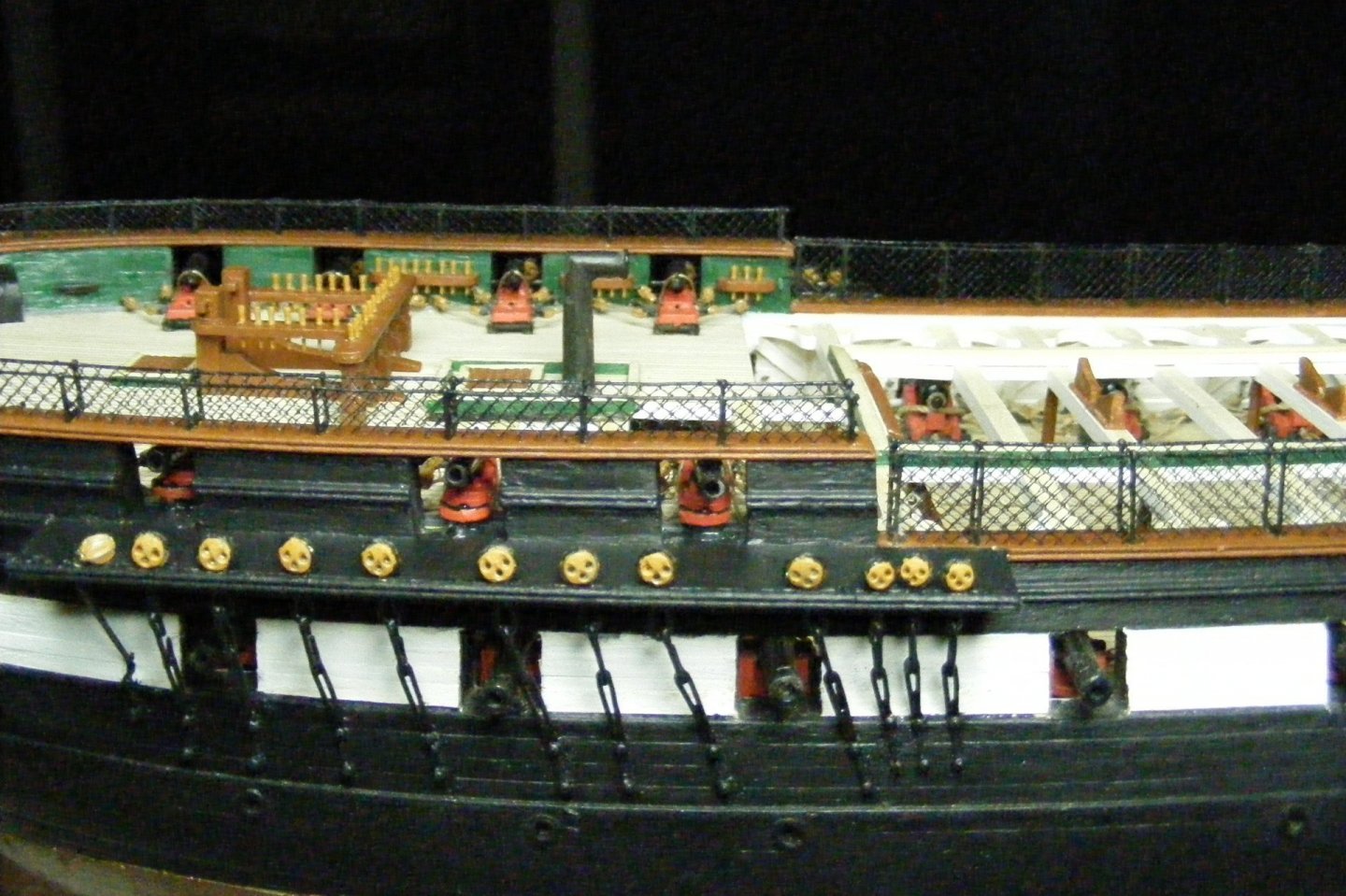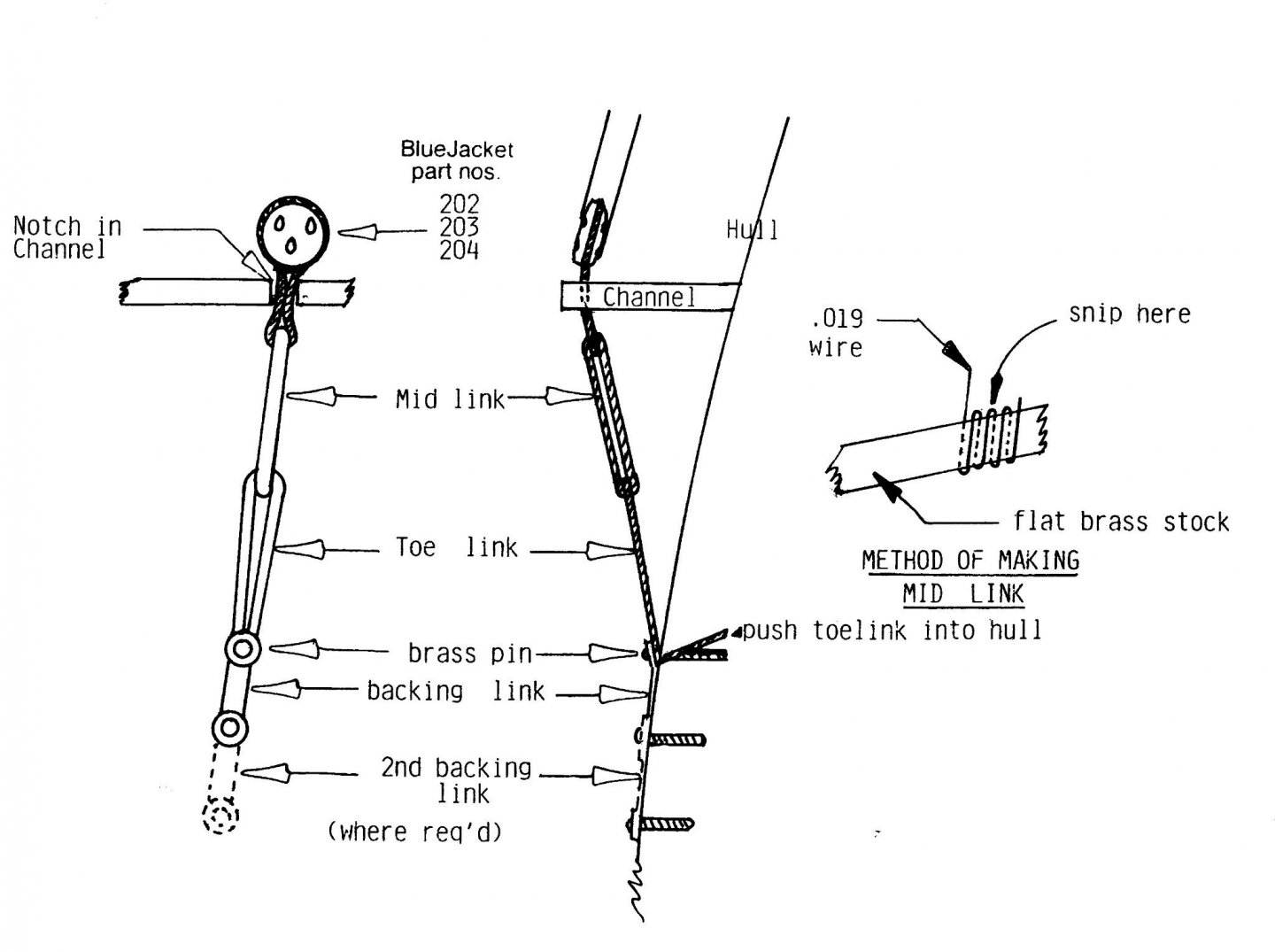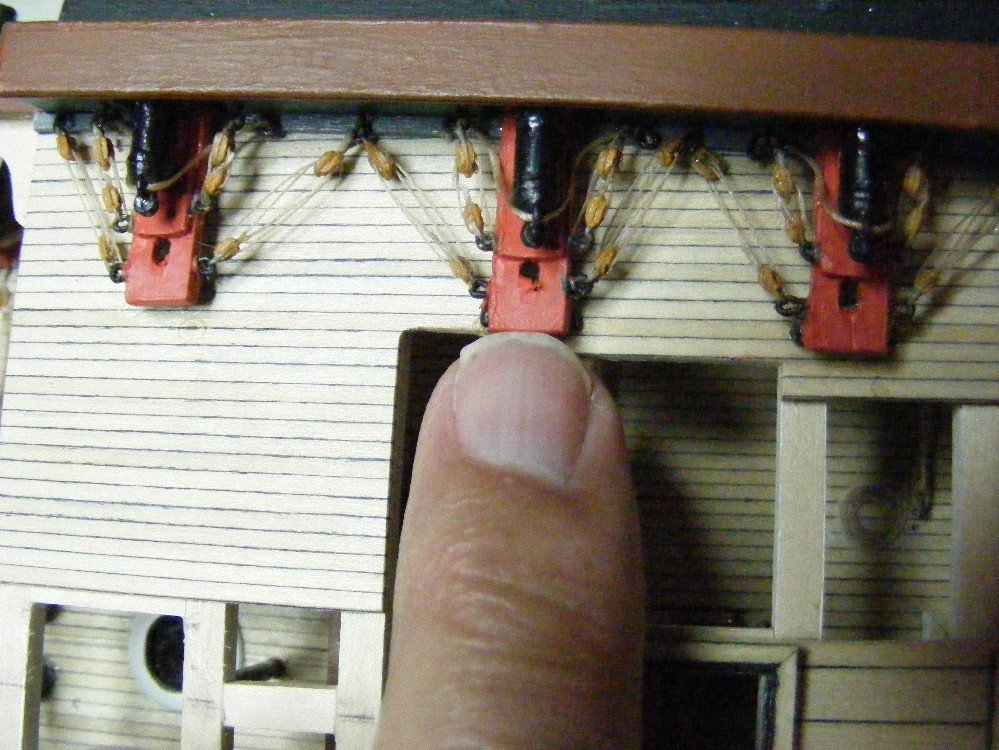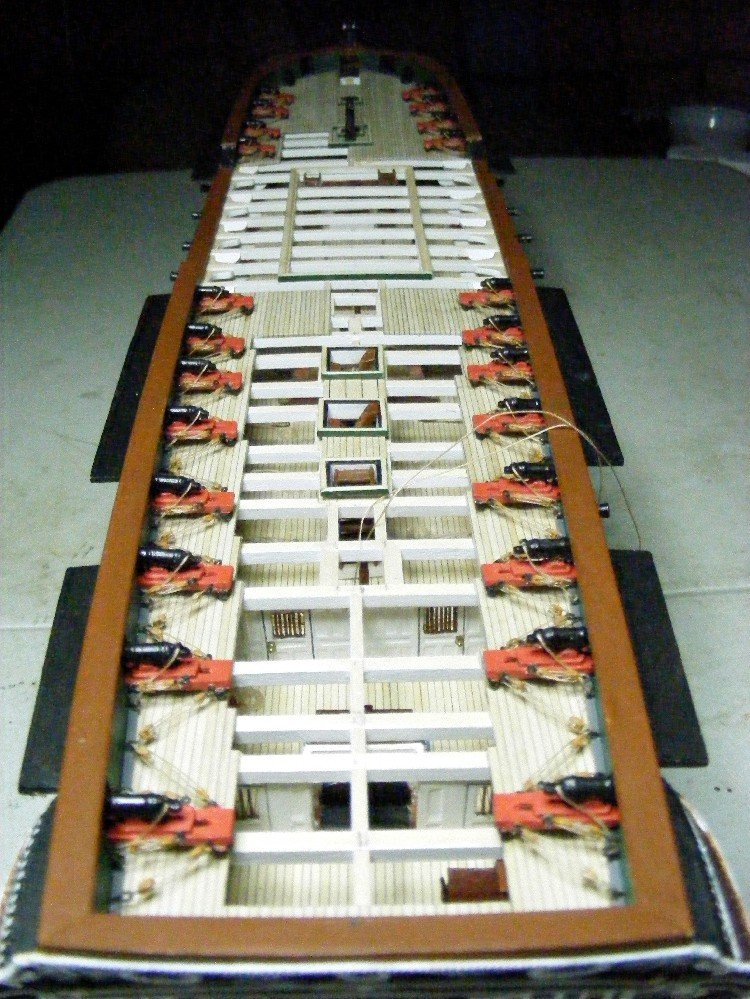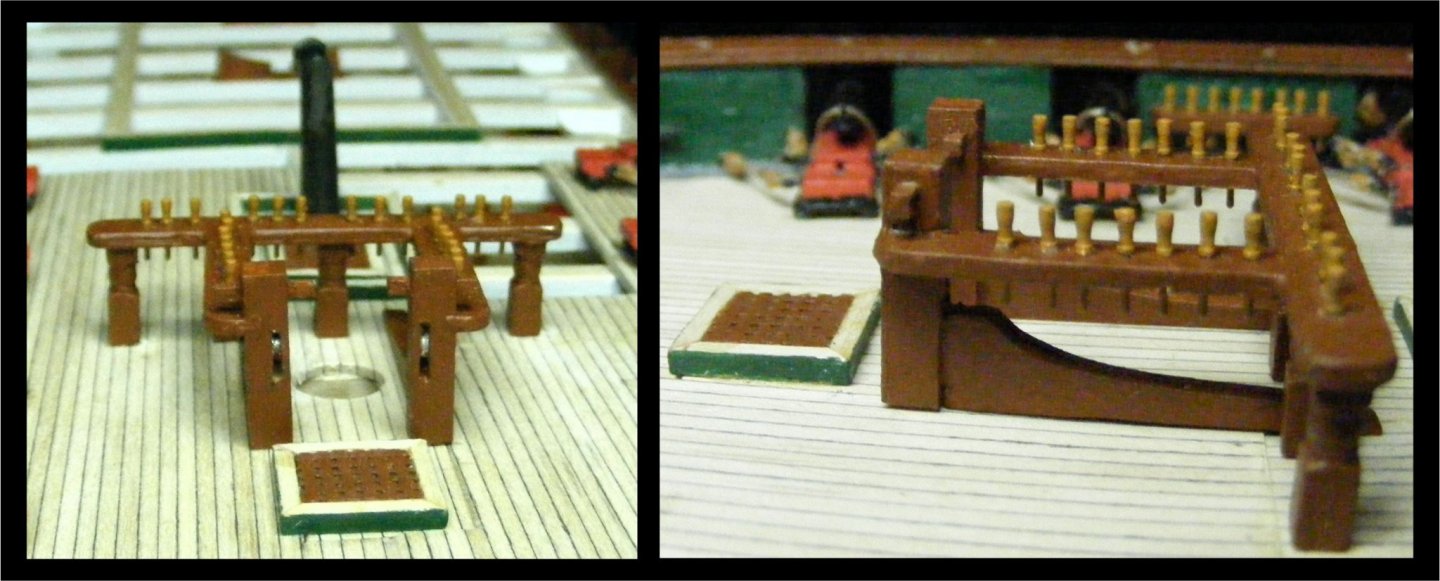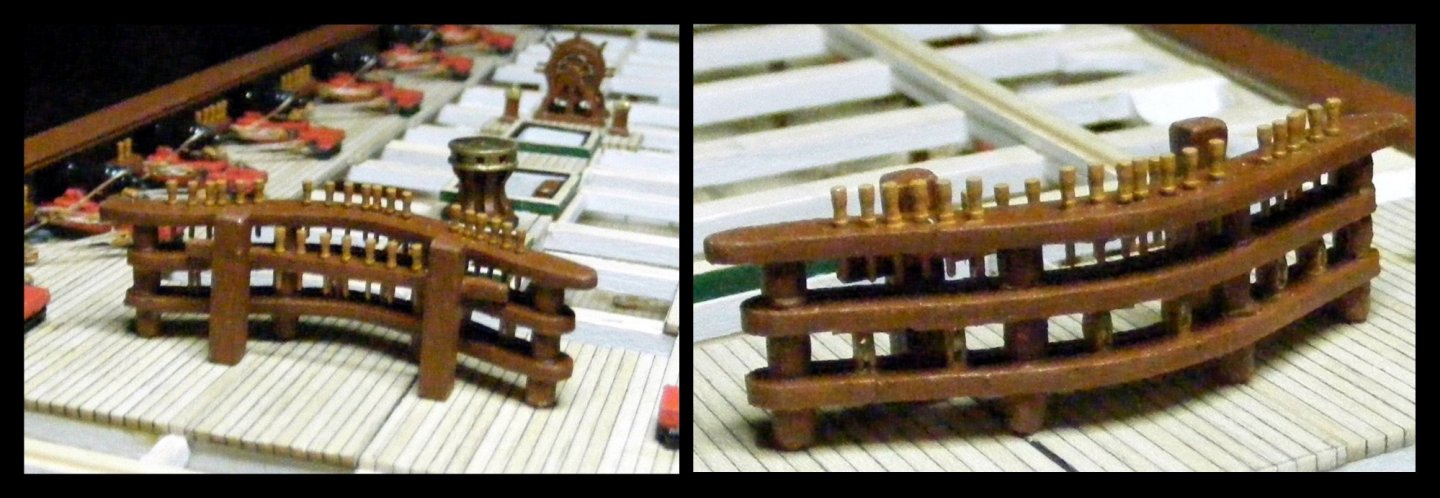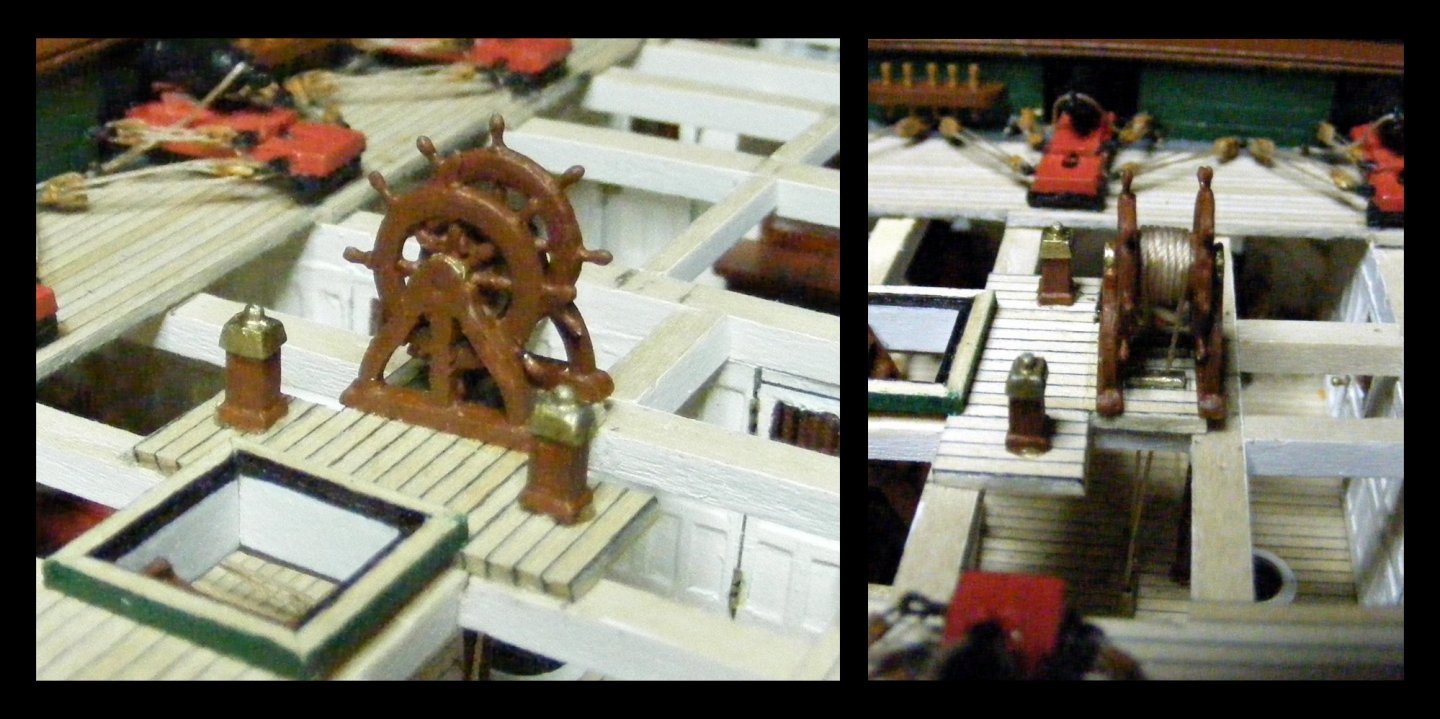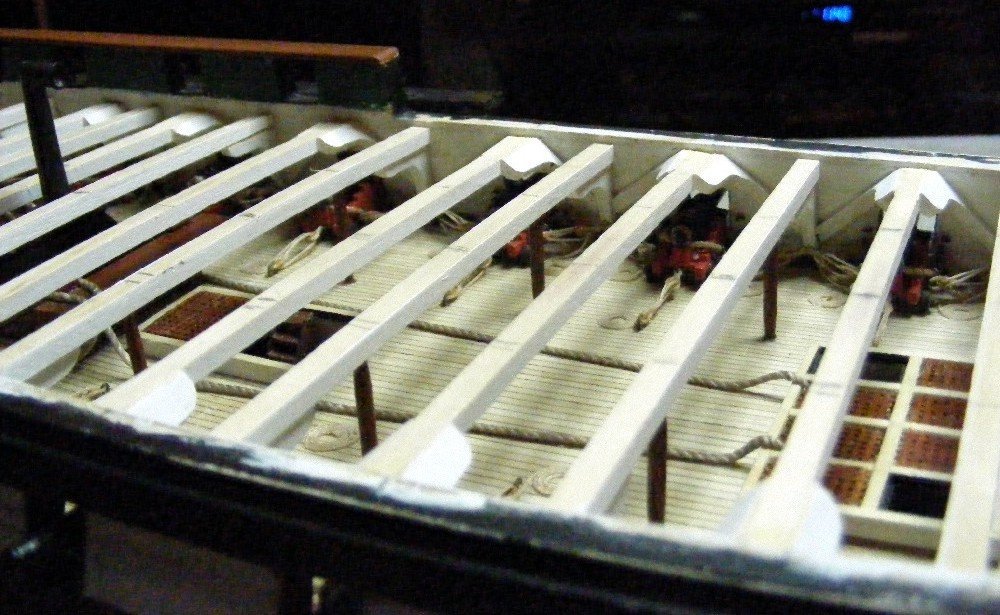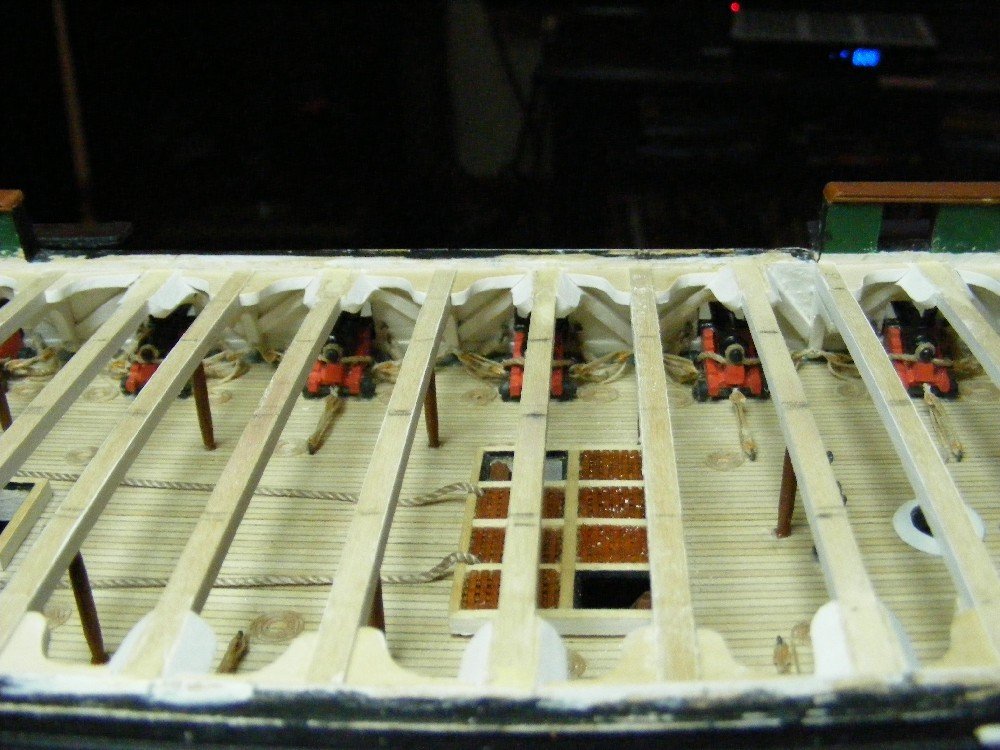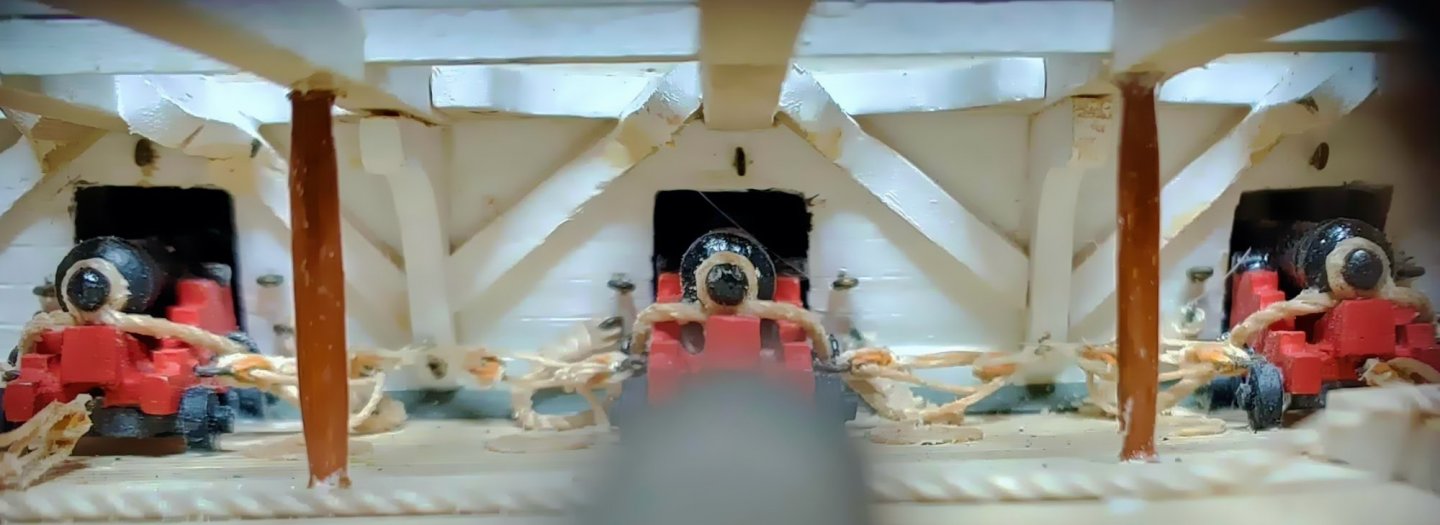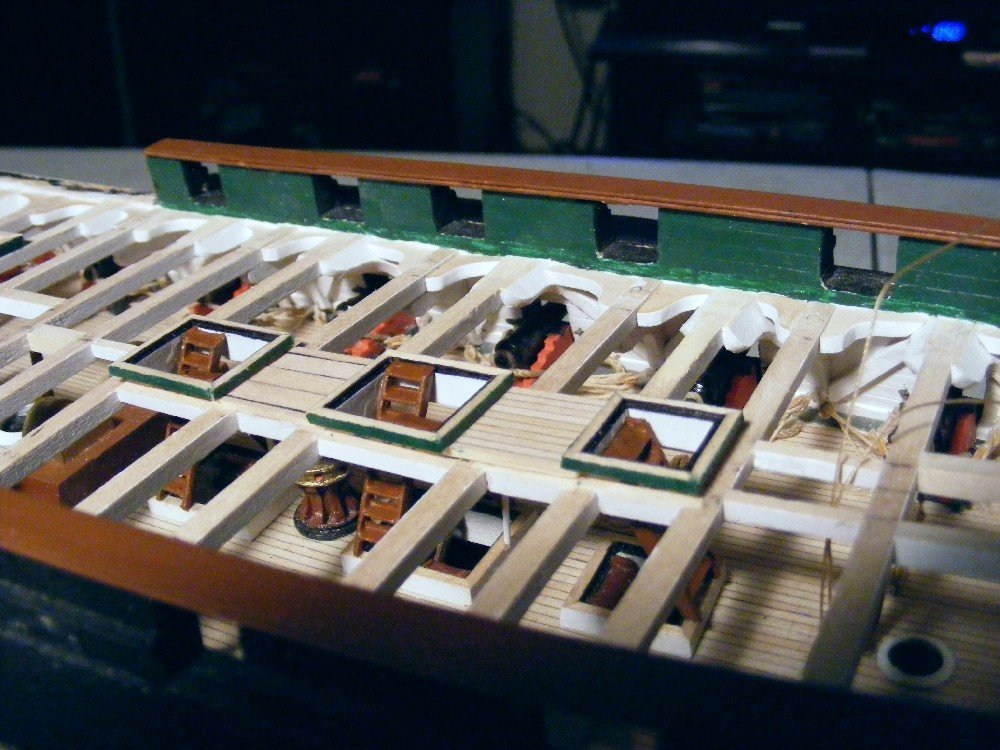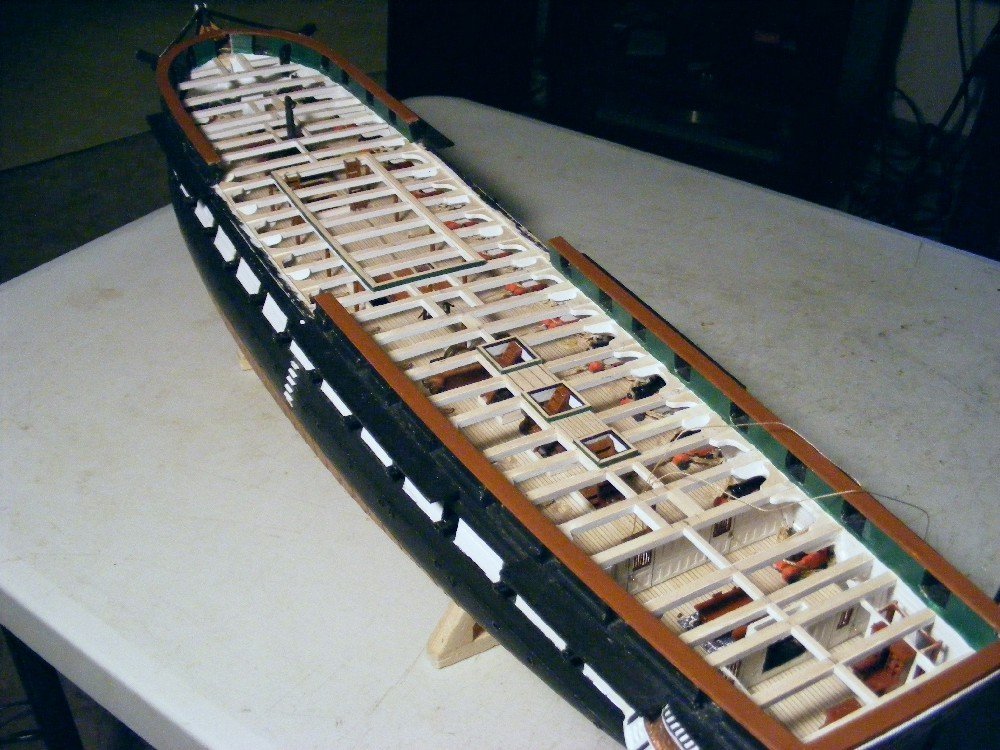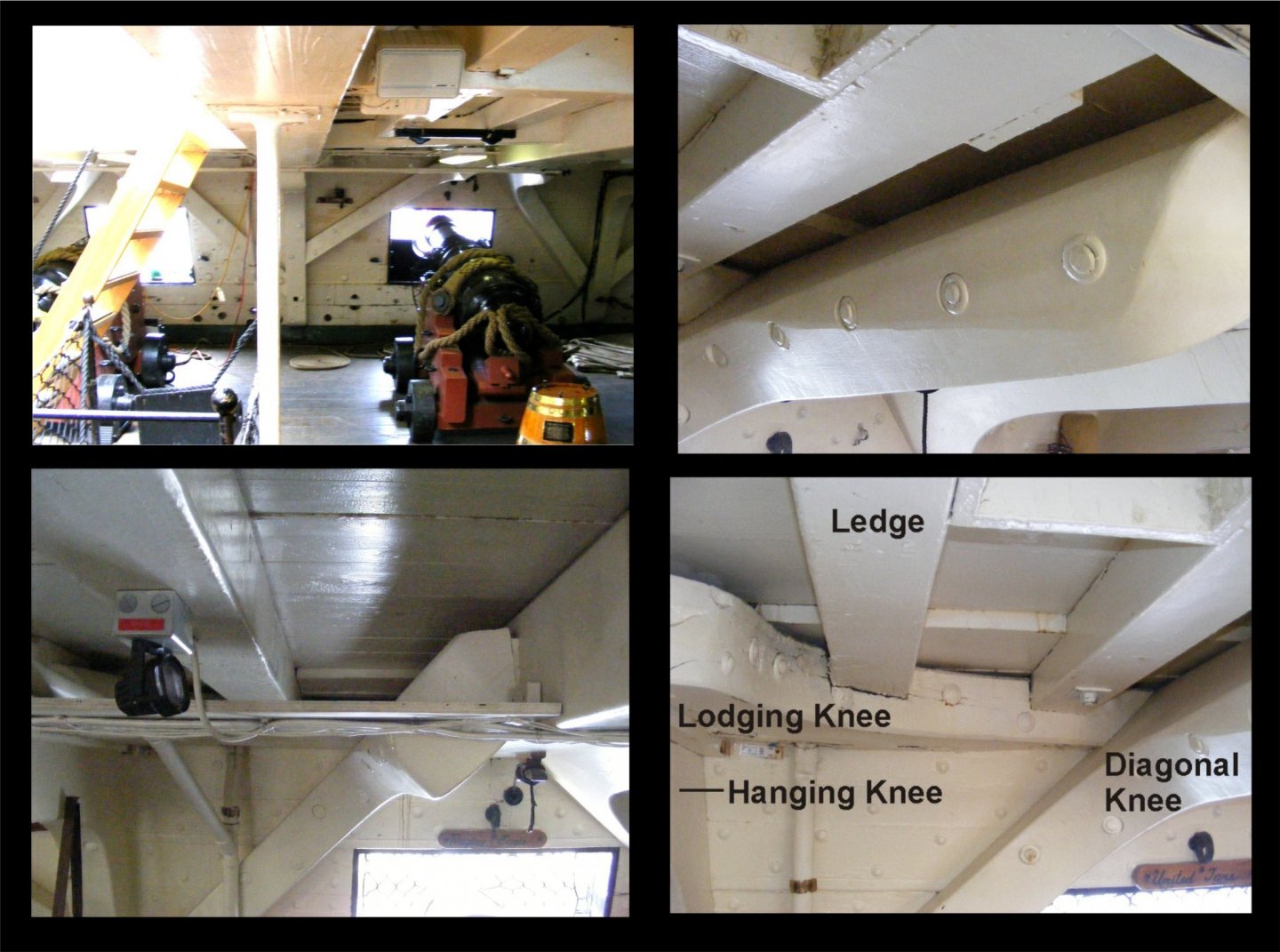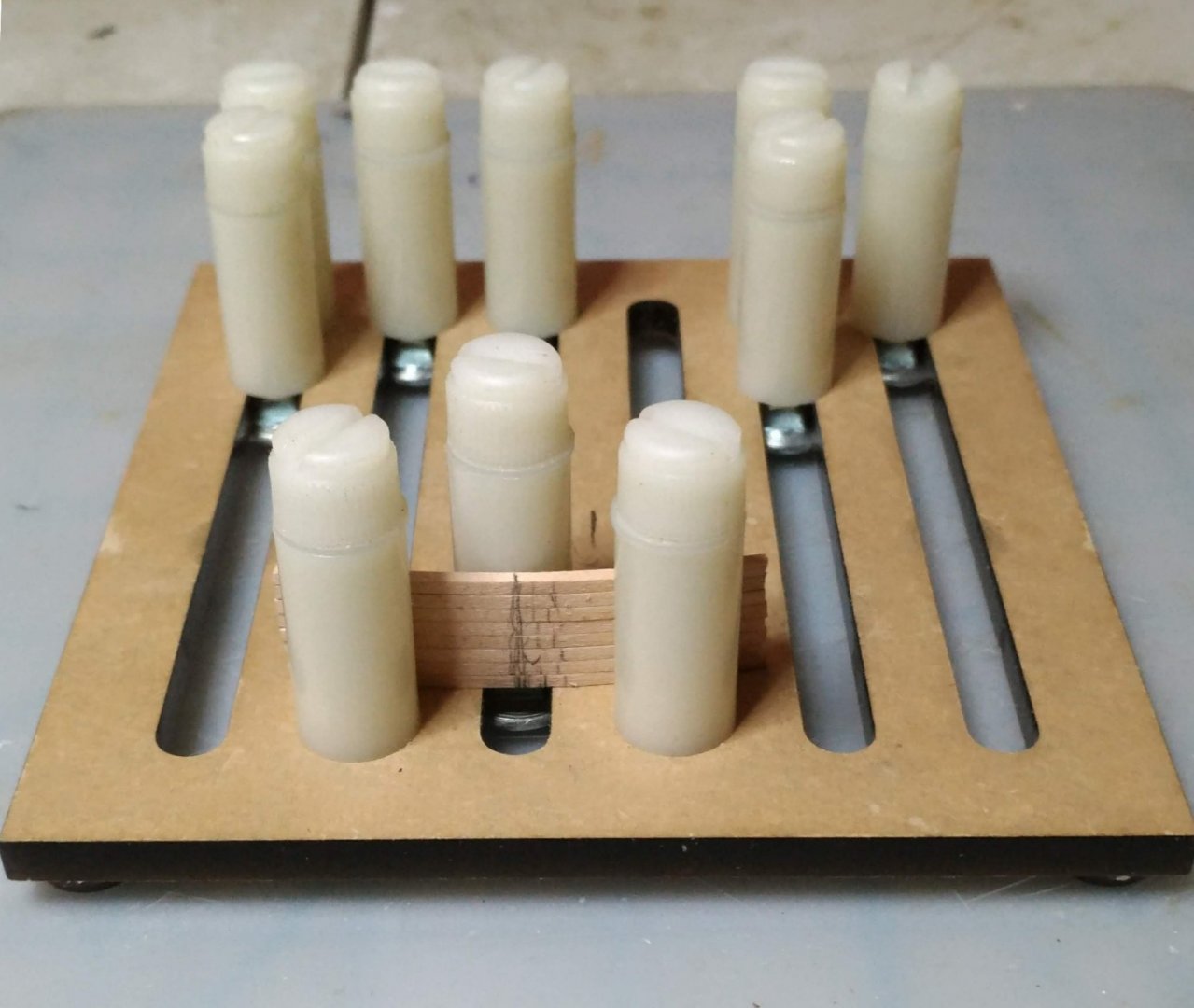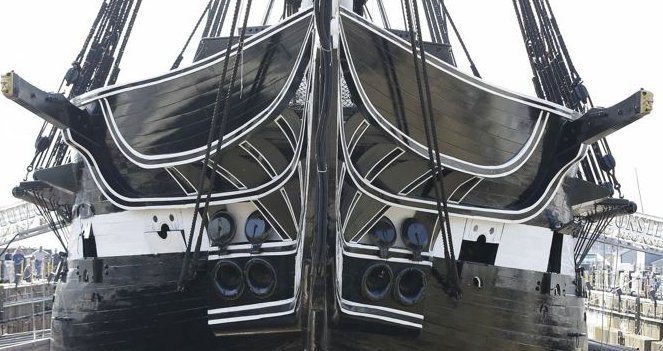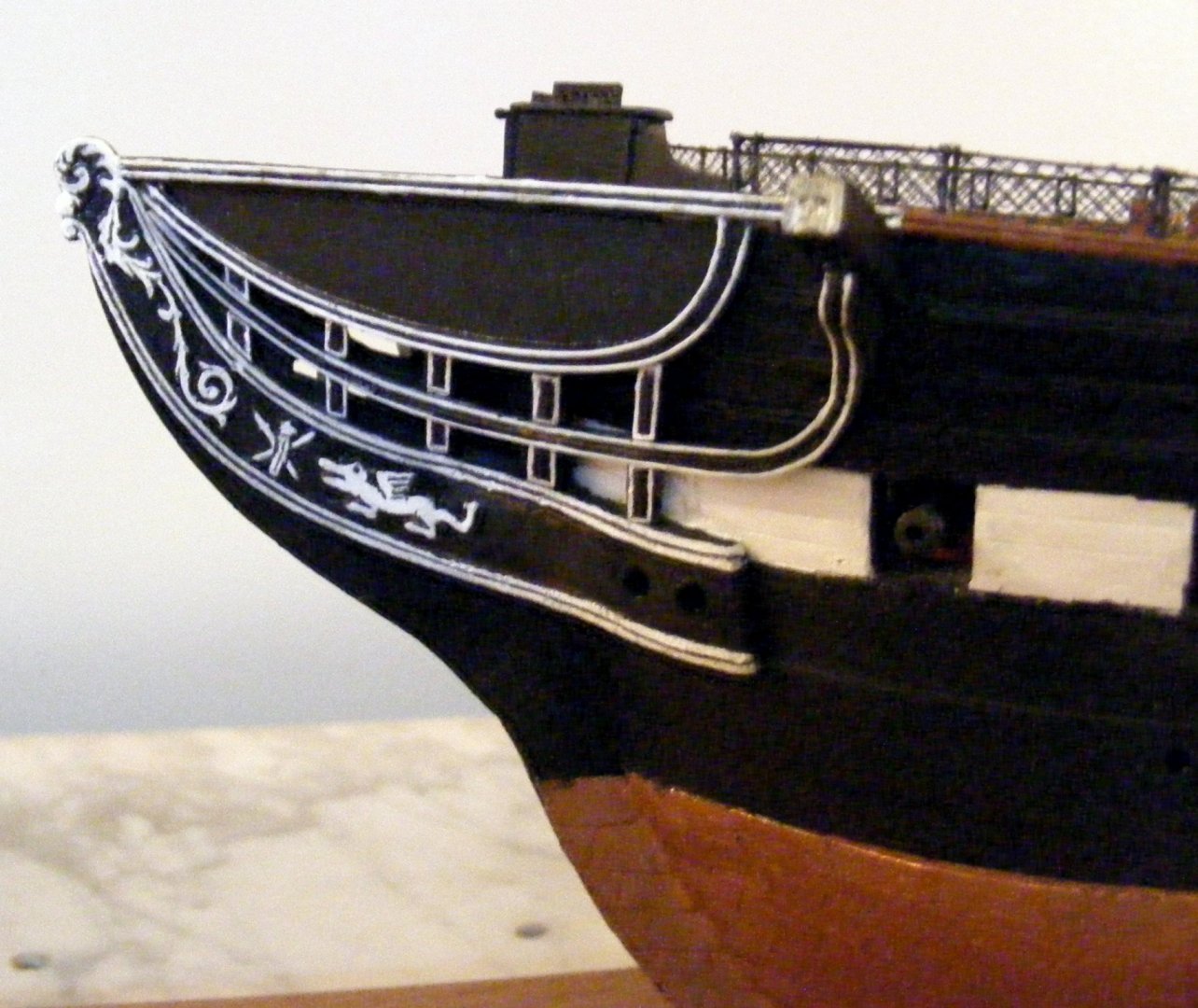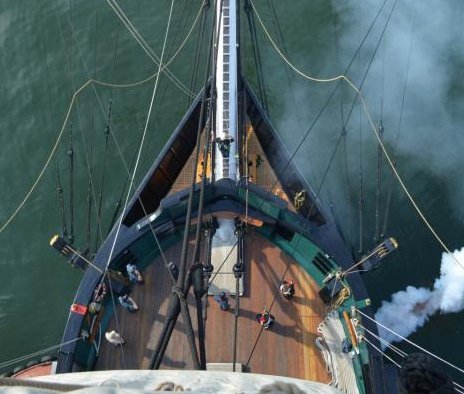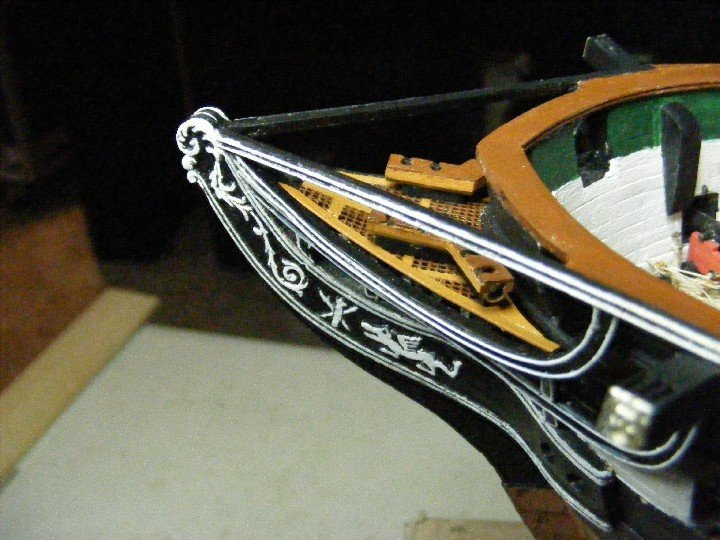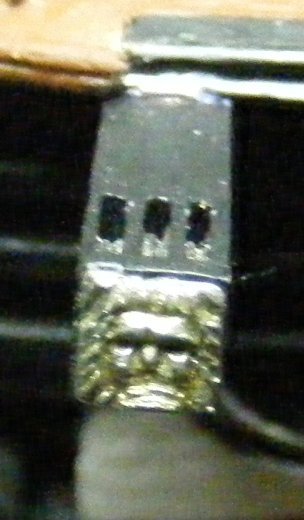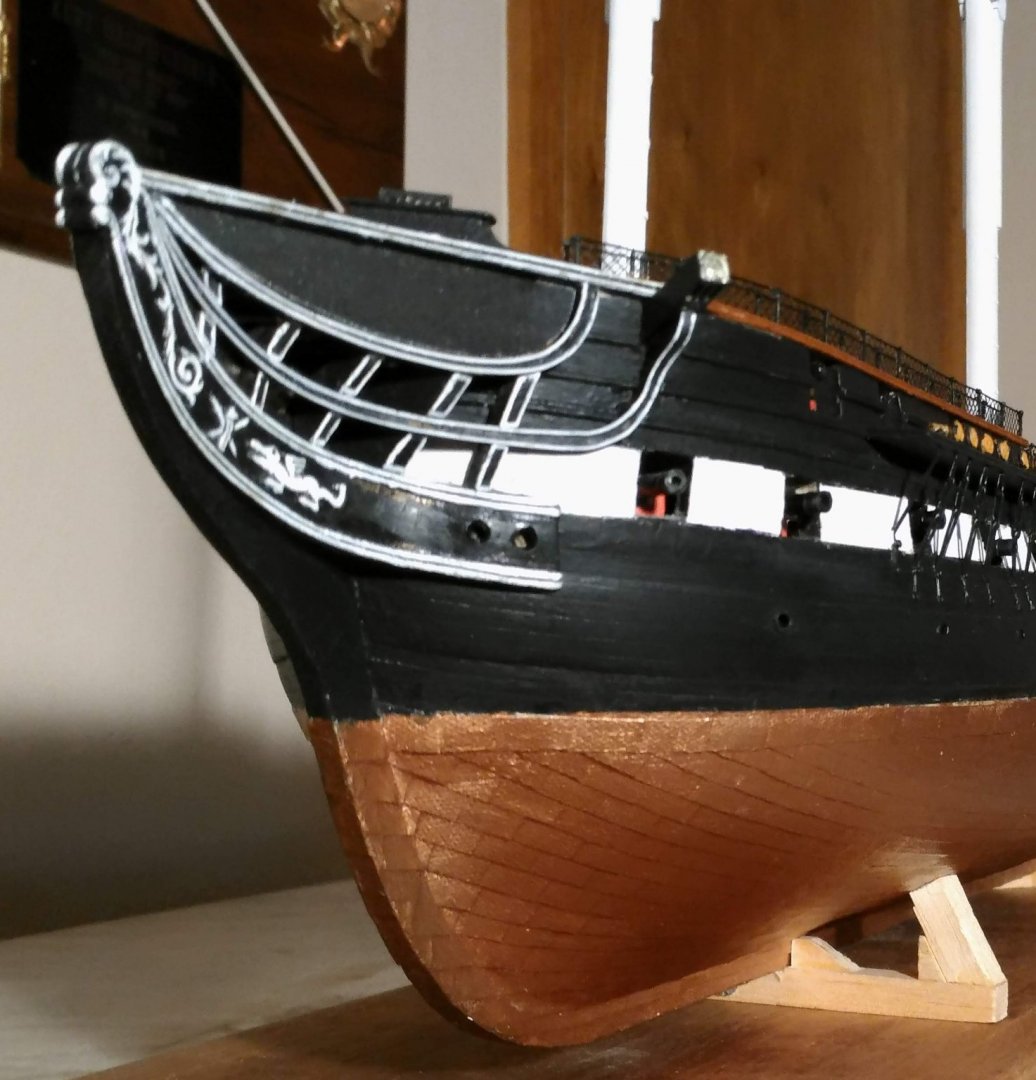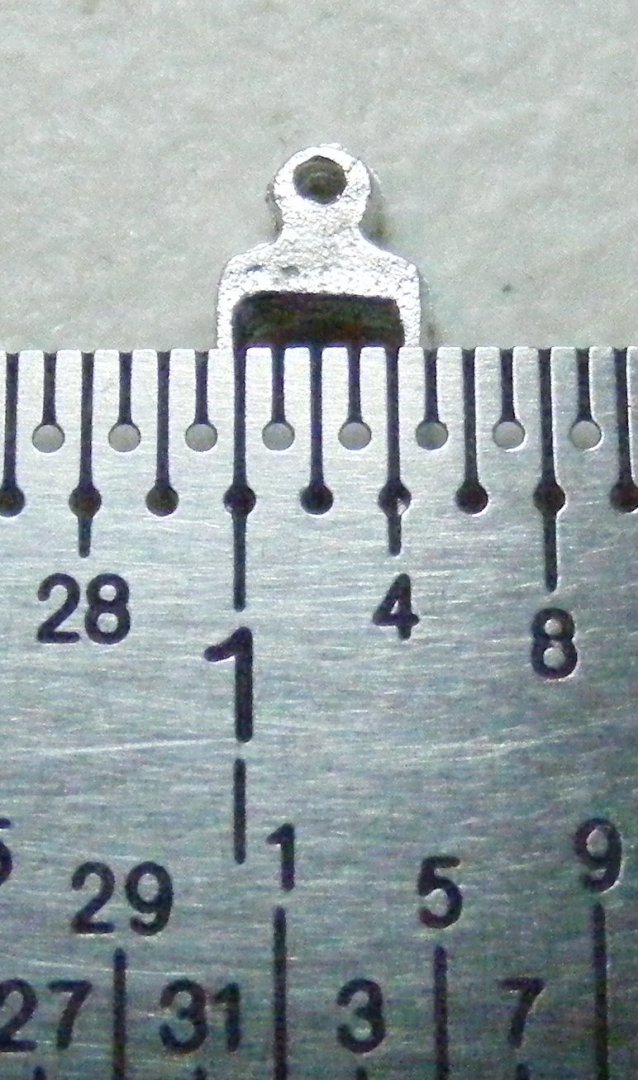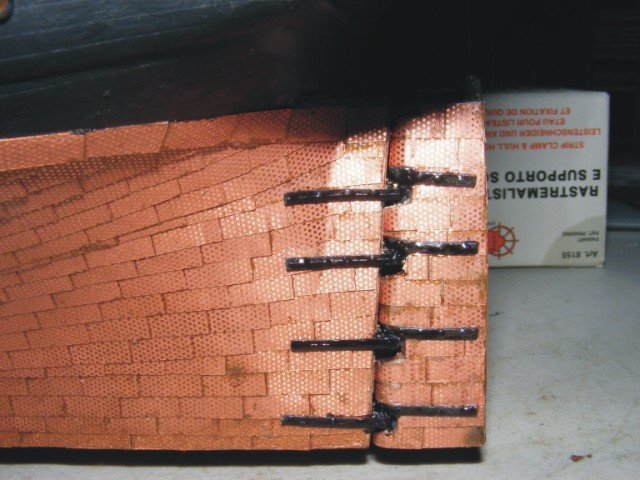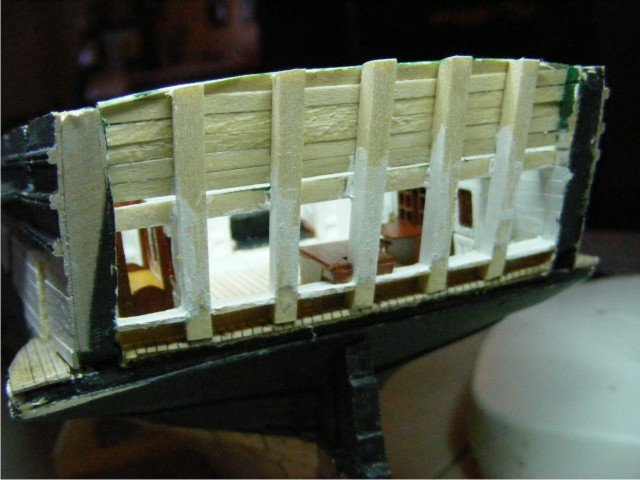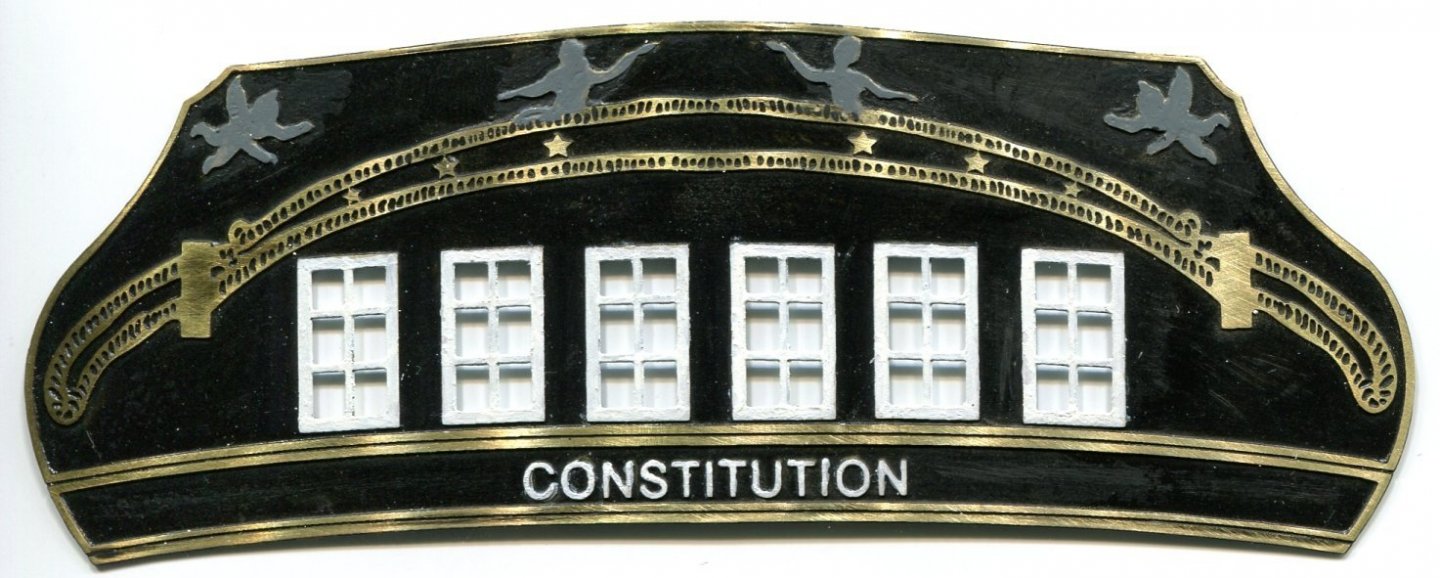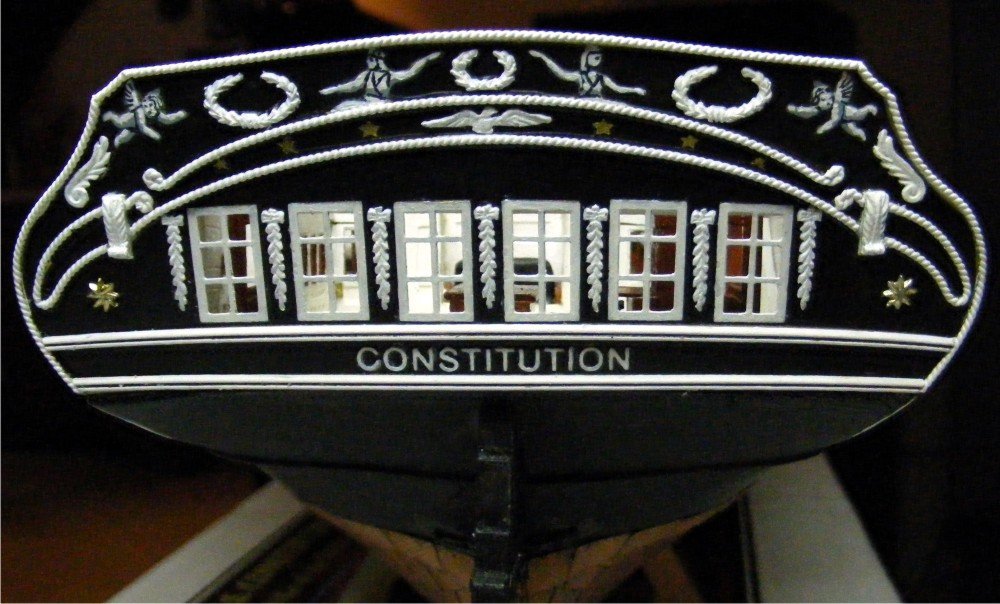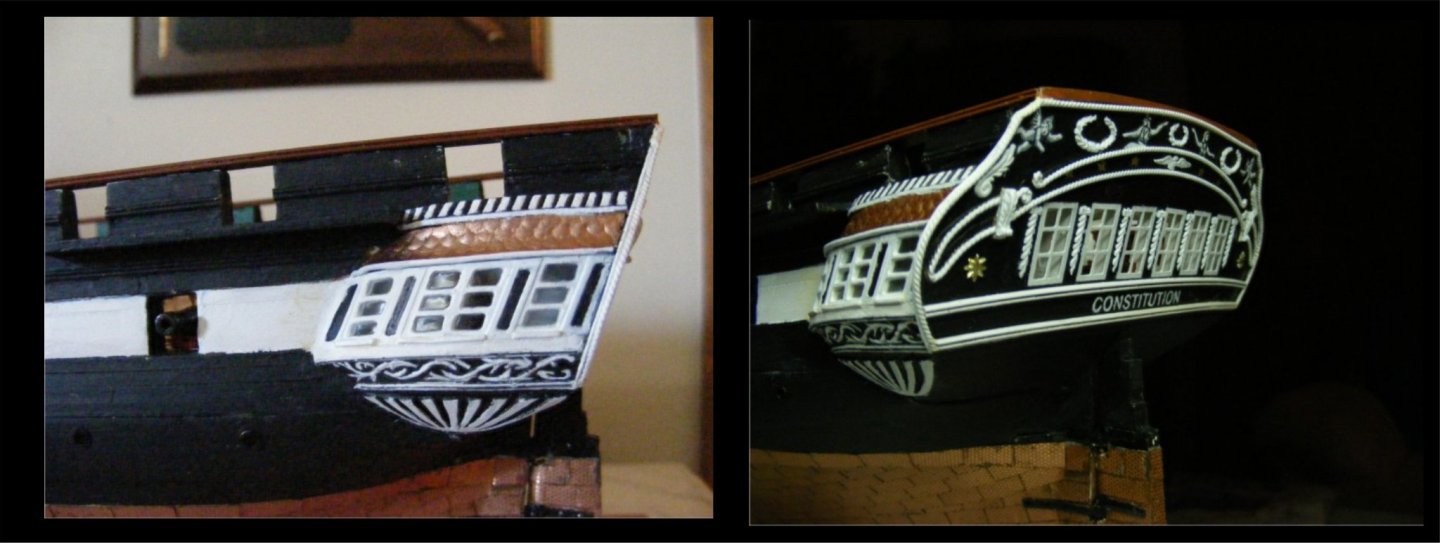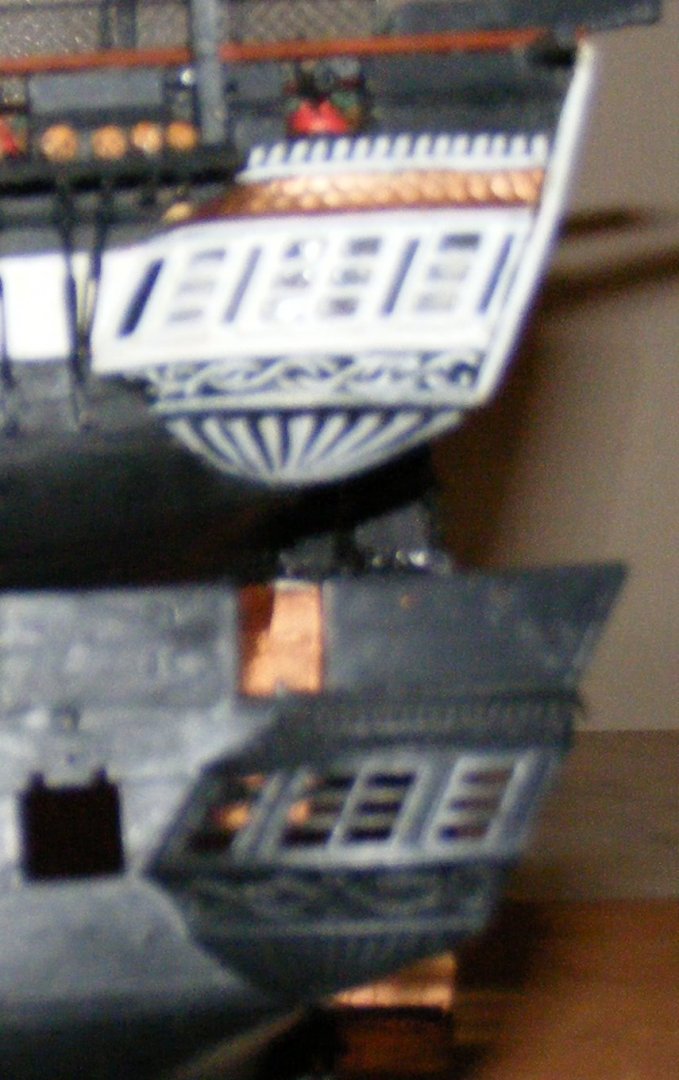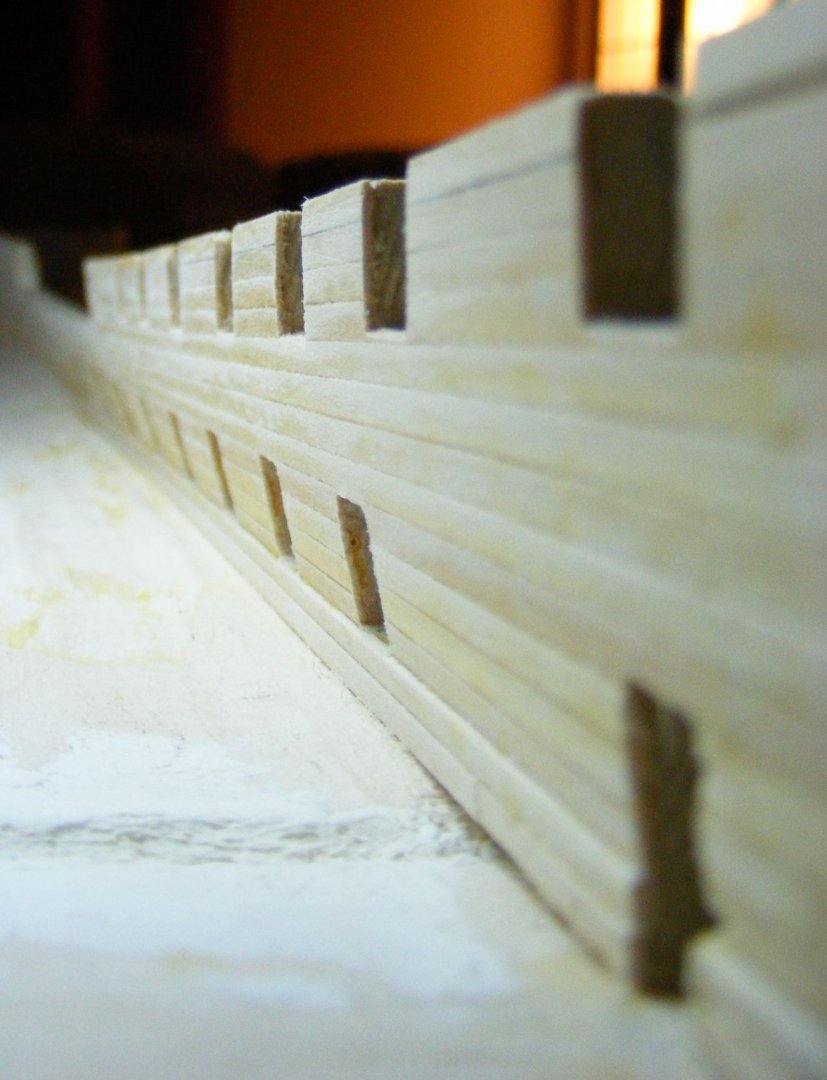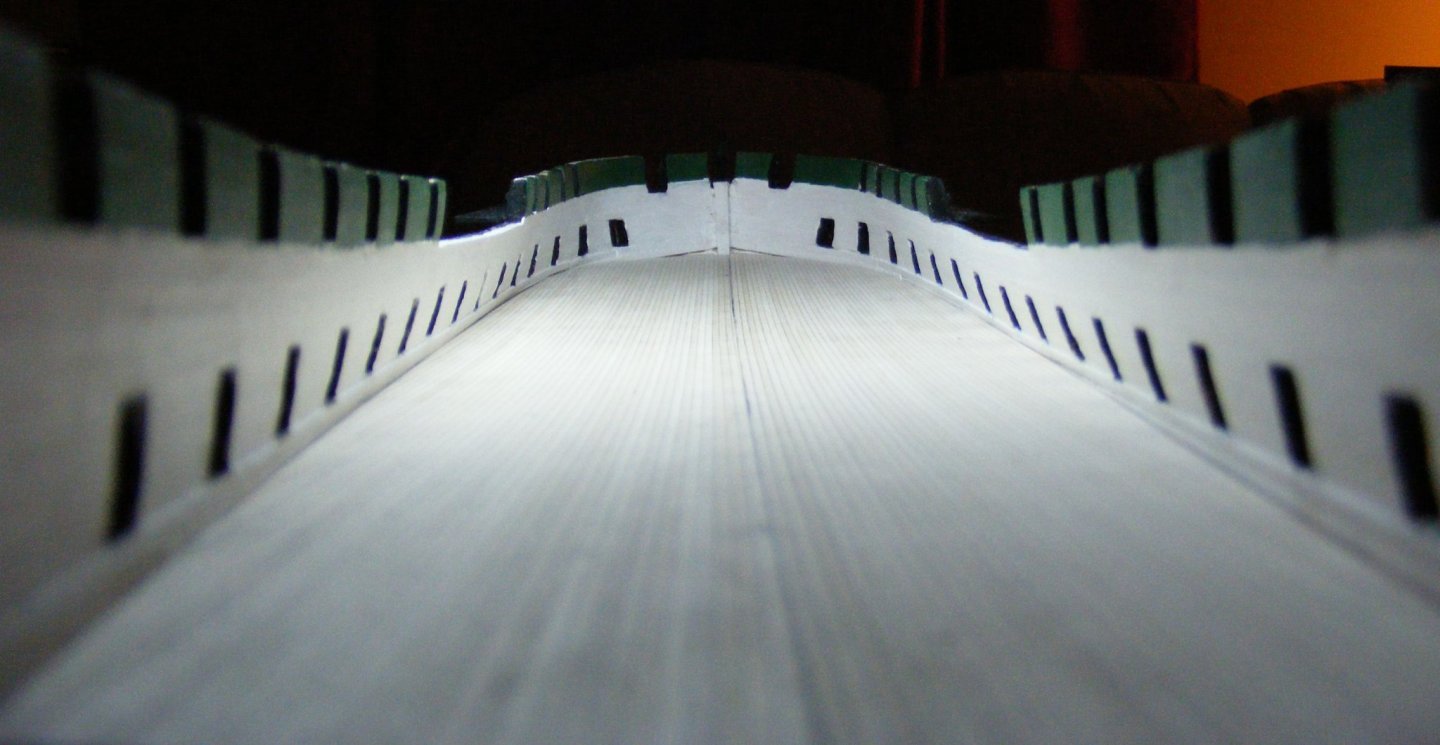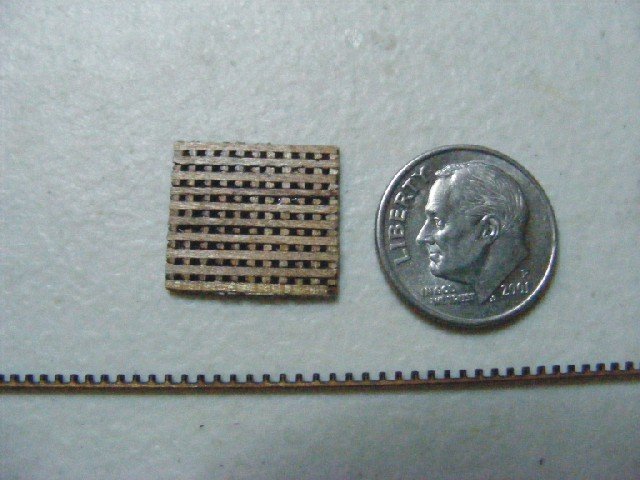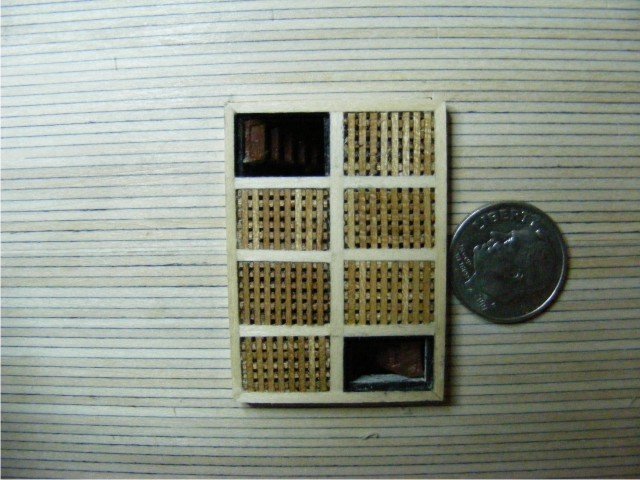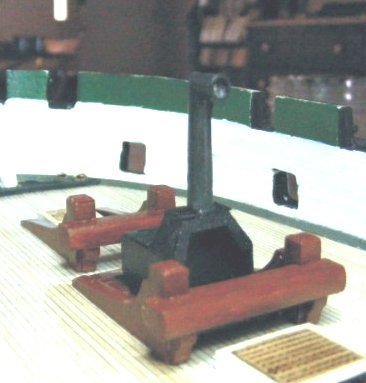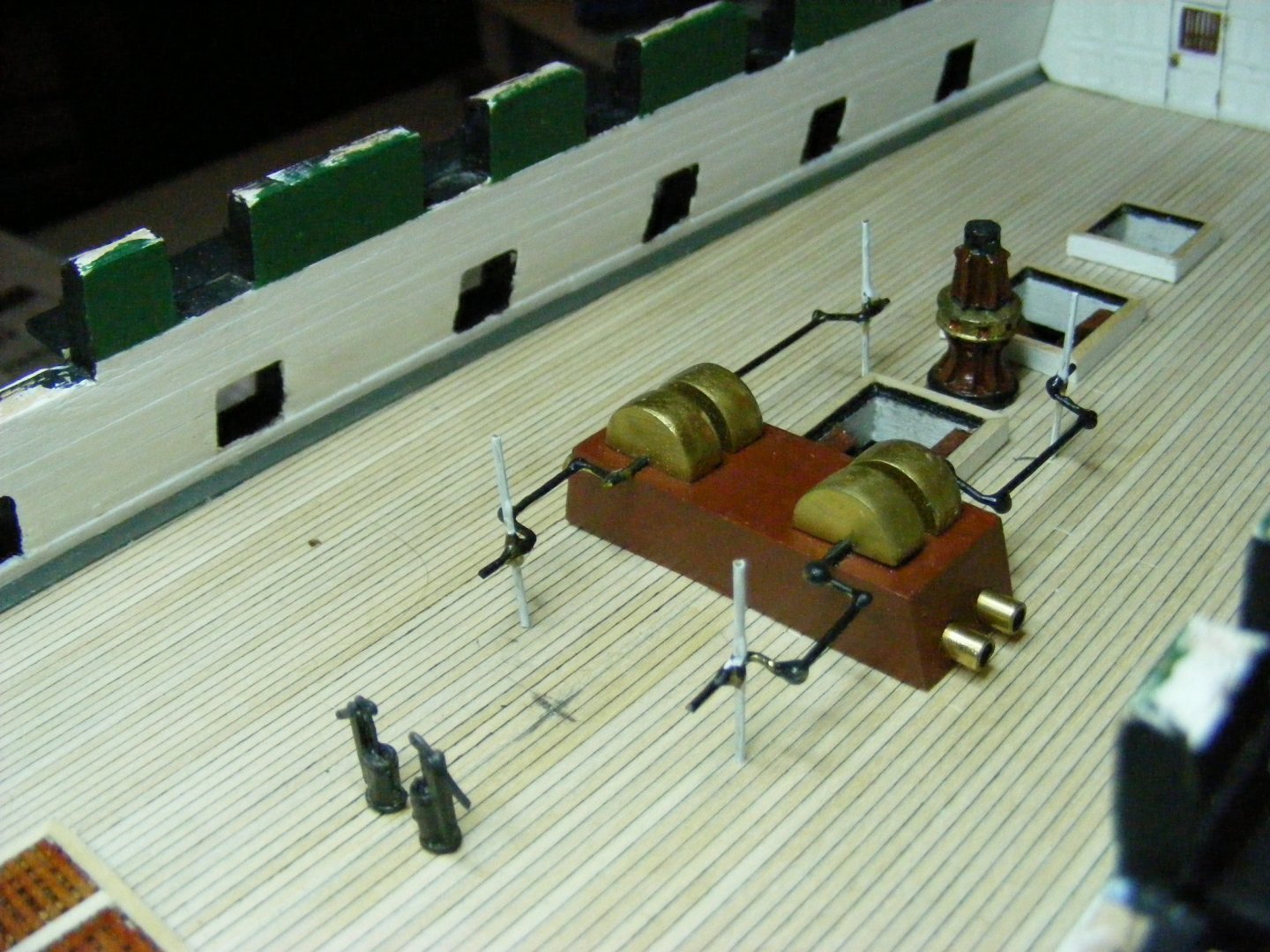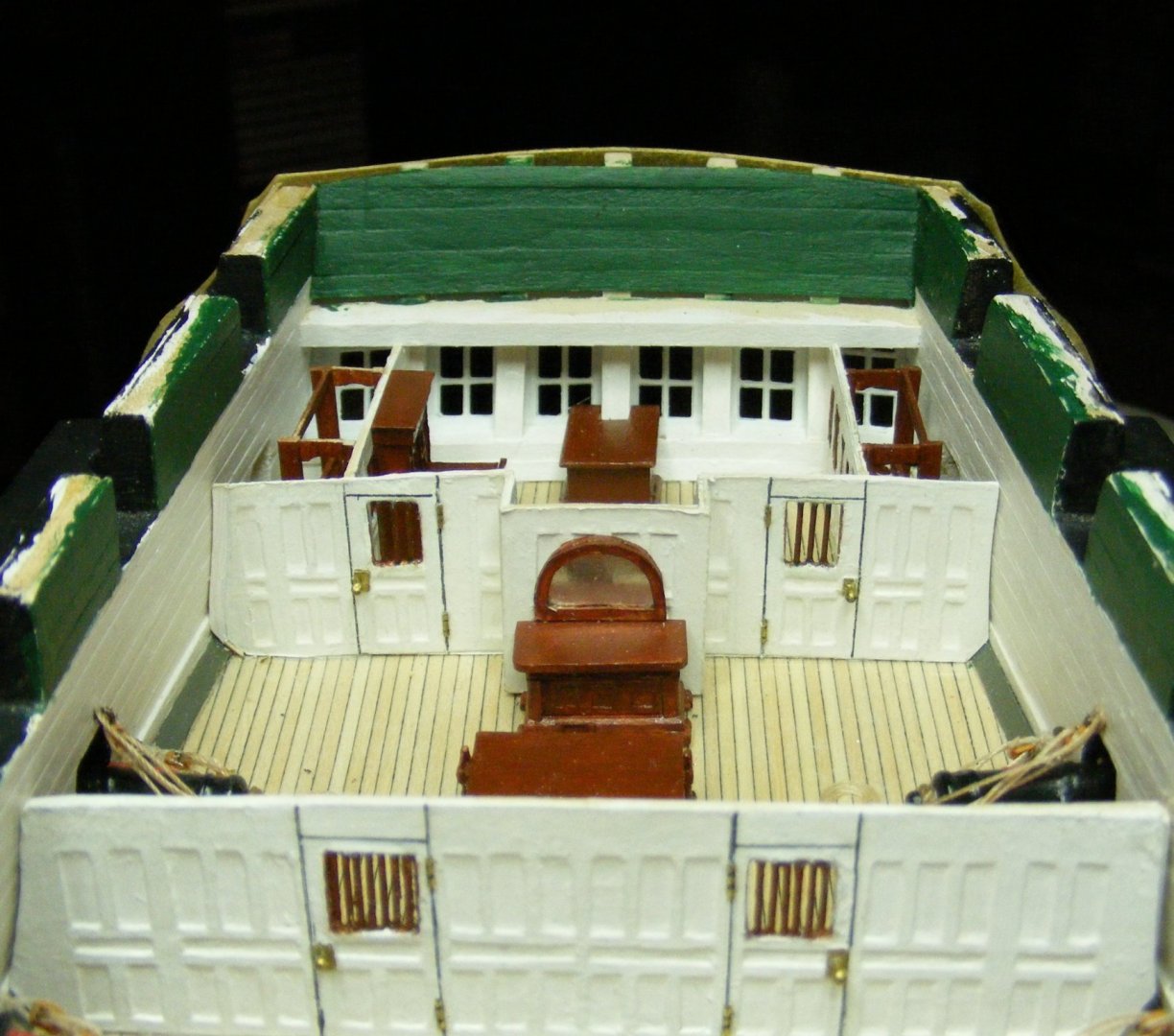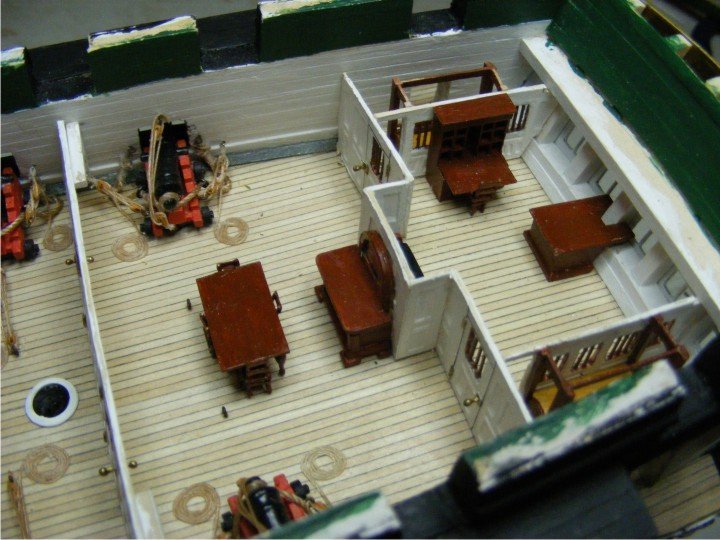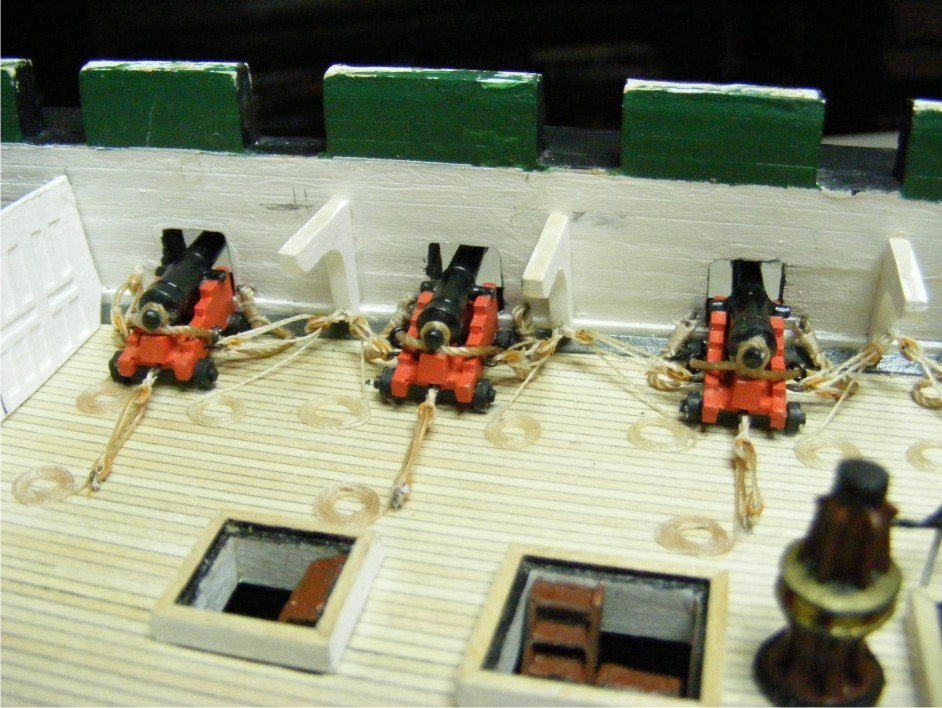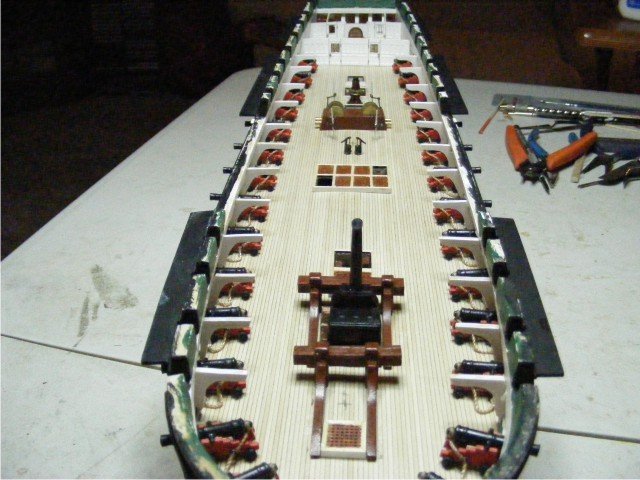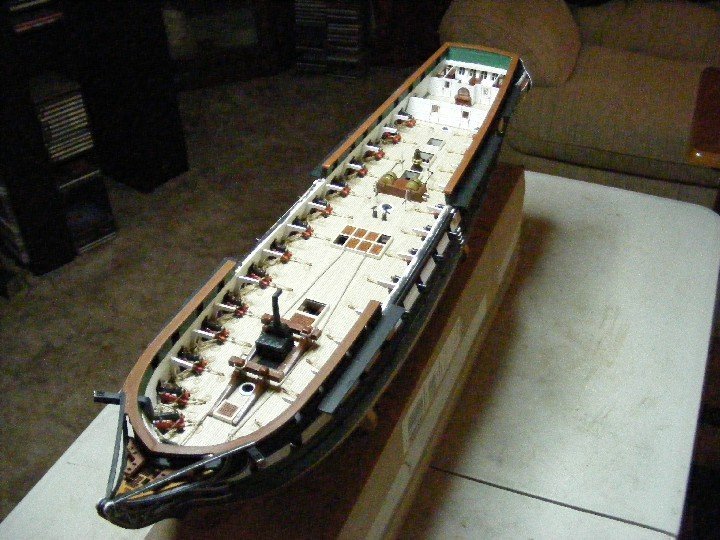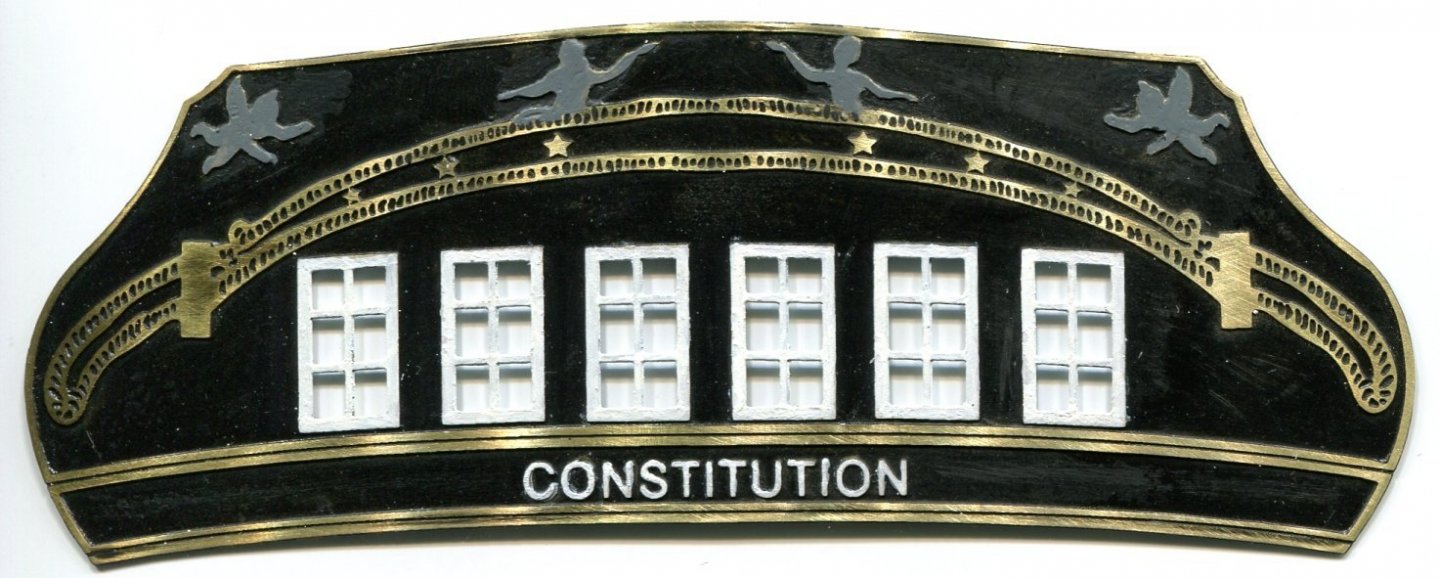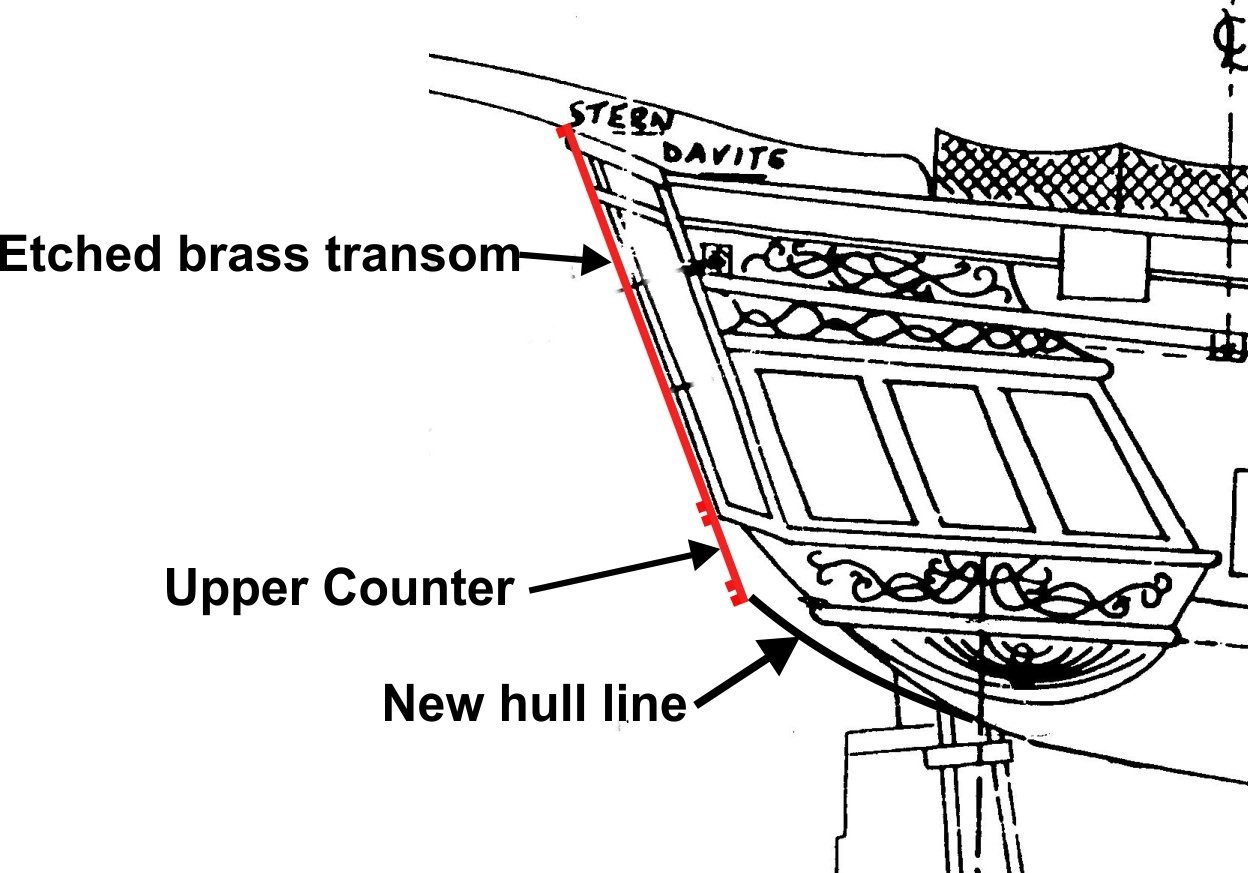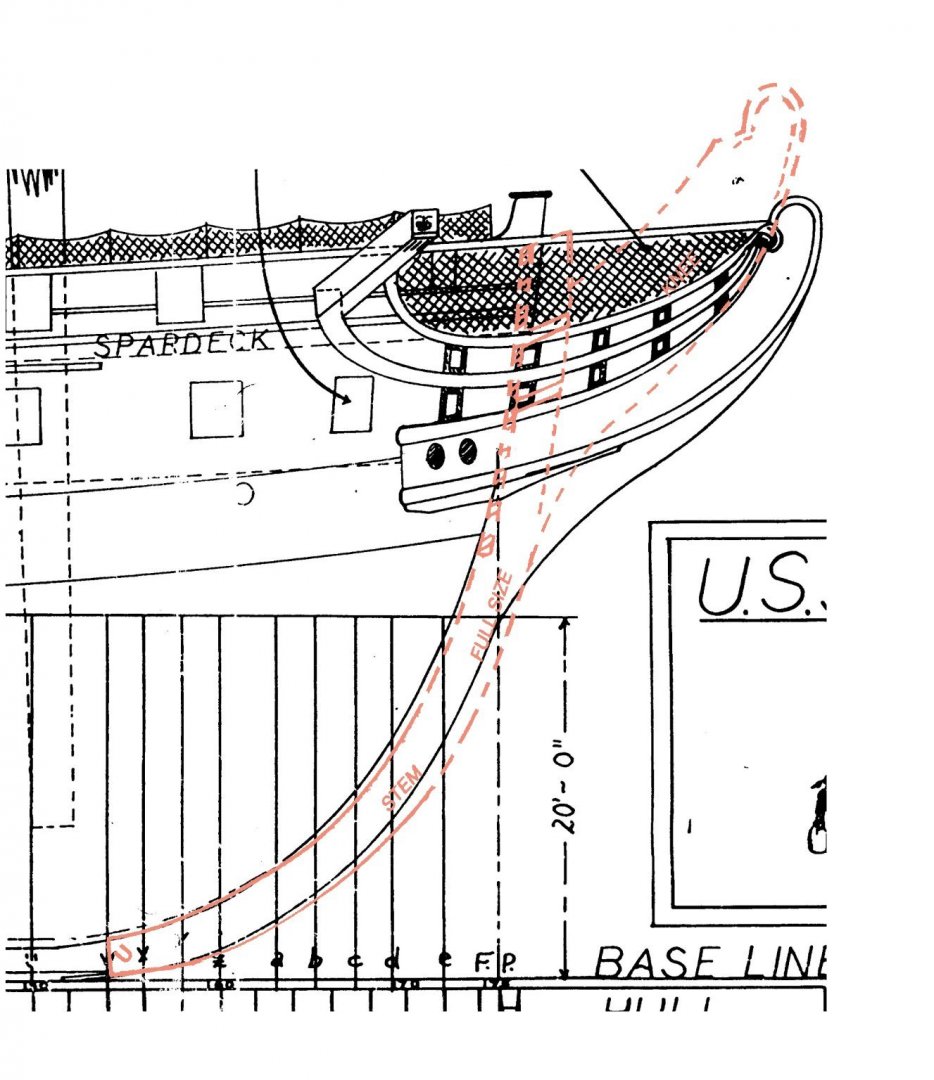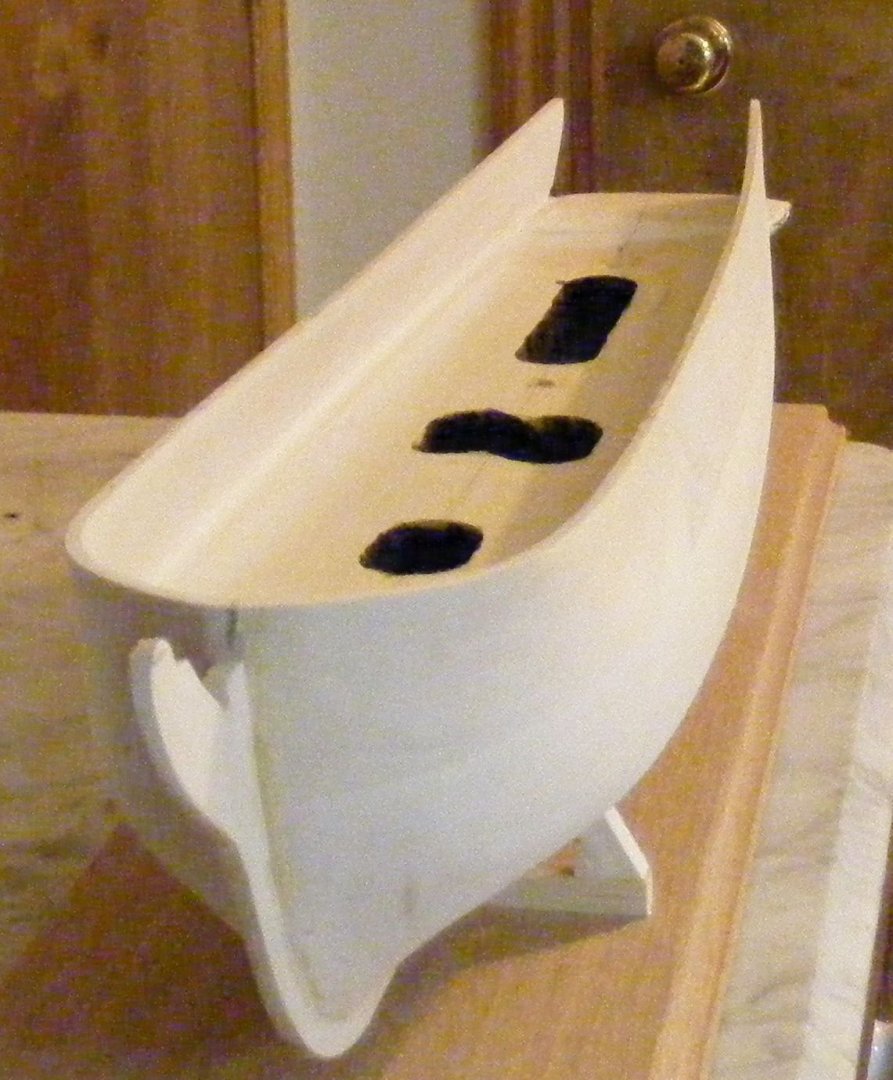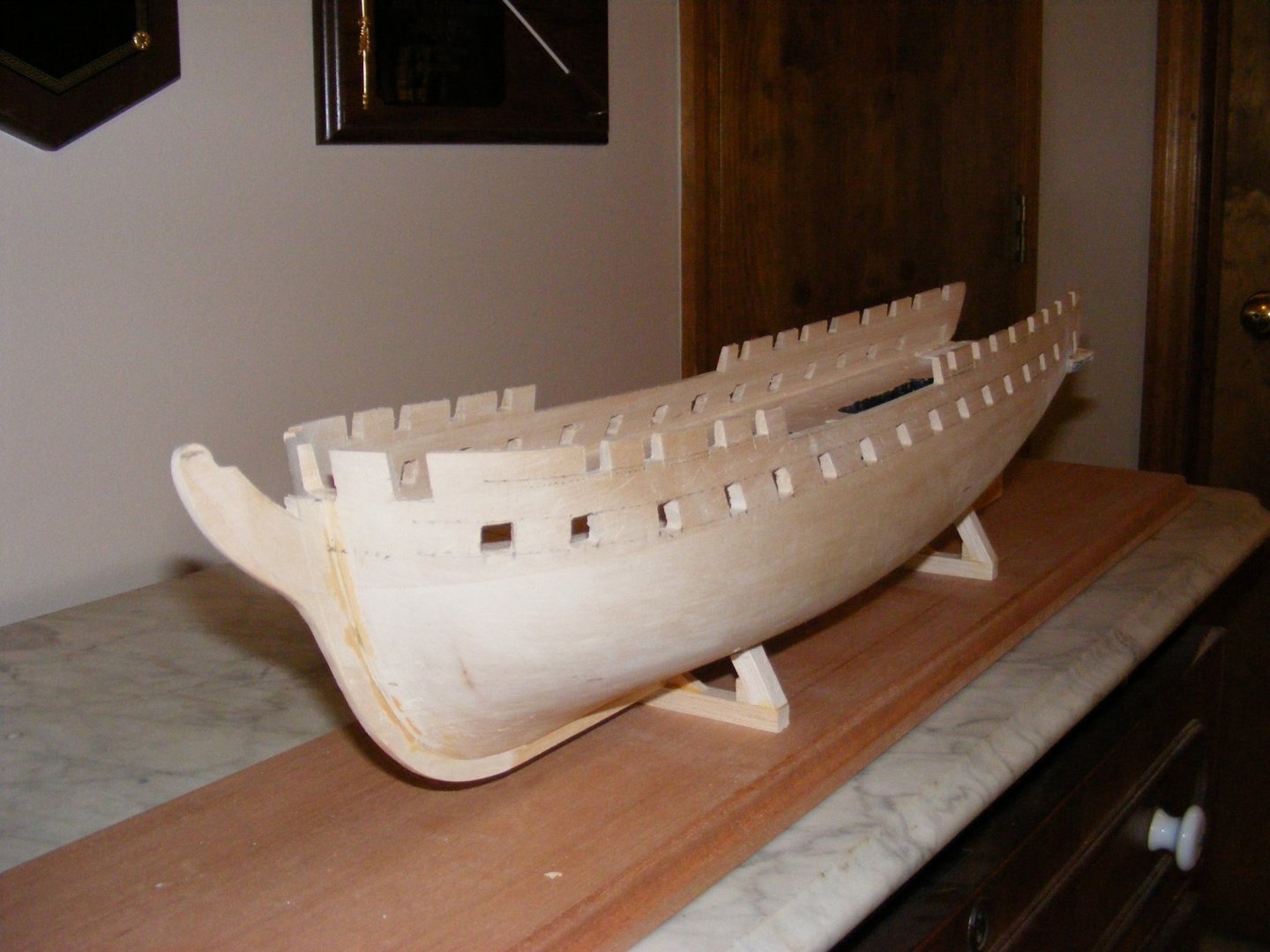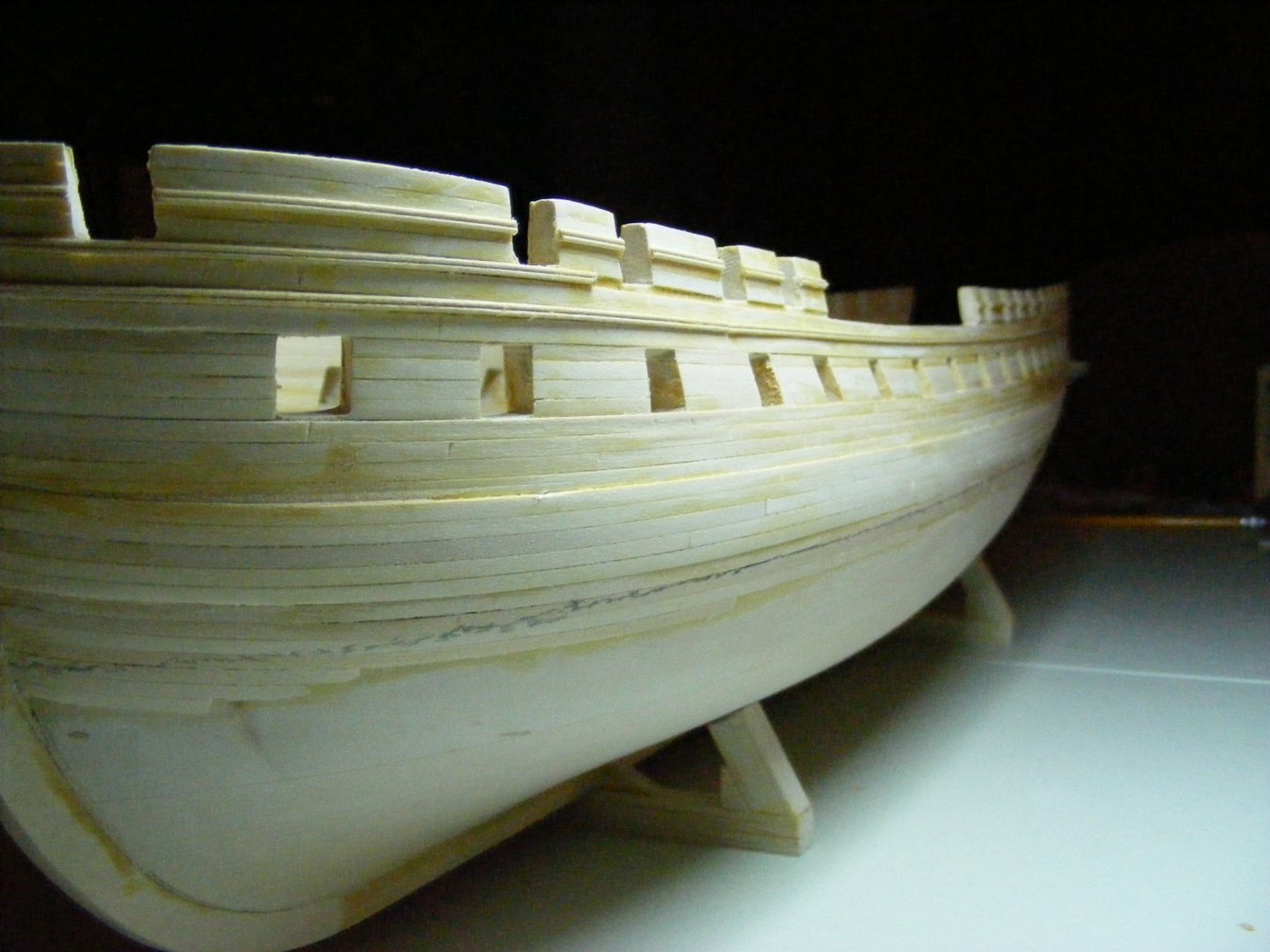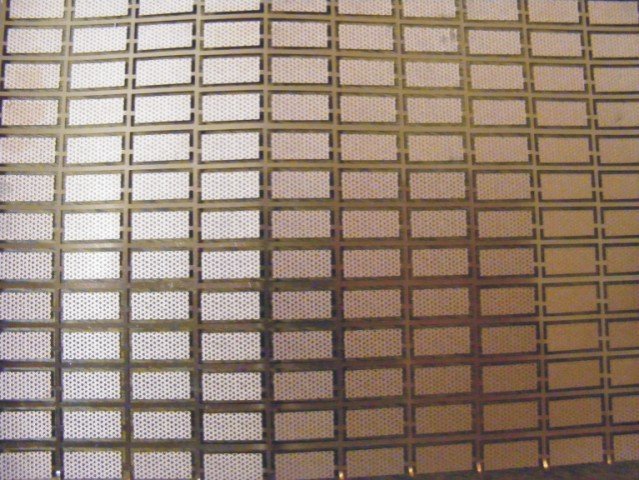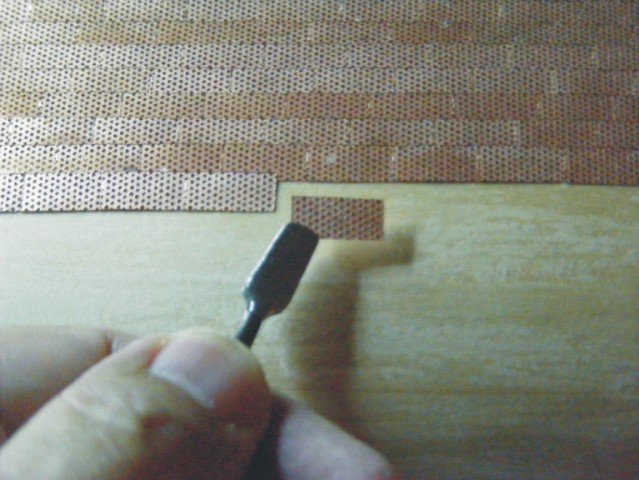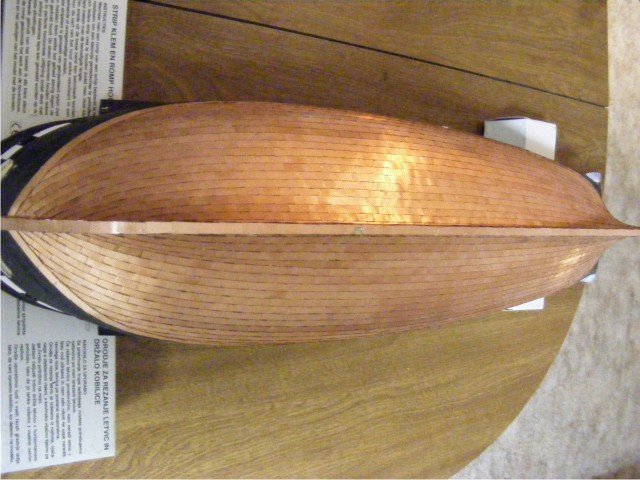
KurtH
Members-
Posts
445 -
Joined
-
Last visited
Content Type
Profiles
Forums
Gallery
Events
Everything posted by KurtH
-
The hammock cranes and netting The instructions recommend installing the hammock cranes last. This would have meant working with them behind the shrouds and ratlines which would have been very difficult, so I did them here. Brass photo-etched hammock cranes are provided. Initial painting of these cranes was done on the sprue with the eyes at the top left natural so as not to restrict the reeving of the line through them. The instructions recommend that slots be cut in the caprail to receive these, but I opted for drilling holes in the rail and inserting the pins at the bottom in and glueing it with CA gel. As I said, these holes should have been drilled before the caprail was installed, but that's the way it goes. Once in place filler was used to fill in any gaps and the joints retouched with MS Hull Umber to match the caprail. Here is a shot of the model with the cranes installed. Also visible is a specially designed box that protects the delicate helm assembly. The line I used for the top of the cranes was Bluejacket #1654, 0.020". Being smooth, it rove easily through the eyes. I stiffened it with liquid CA which gave the assembly much needed stability. White netting is included in the kit, but I wanted black, so I got some 1/16" netting at Joanne's which looked perfectly in scale to me. I used contact cement and CA gel to secure it to the cranes, touched it up with black paint as needed, and trimmed the top. This is the result:
- 112 replies
-
- Bluejacket Shipcrafters
- Constitution
-
(and 2 more)
Tagged with:
-
The chains The kit includes the following components for making up the chains: metal stropped deadeyes, photo-etched brass backing links, and a coil of wire. The construction of these chains is illustrated in the book: Notches were cut in the channels, the castings were glued in with CA gel (I would use black epoxy if I had to do it over). You do not want these things to move while constructing the chains or when reeving the lanyards. They were then enclosed with a 1/16" double bead strip from BJ. When securing the back links to the hull, I applied a drop of liquid CA, and let it wick in thinking that any shine could be covered up with a black paint touch-up. It turns out that I could apply 99 coats of paint and the shine will still be there. Lesson learned. I should have applied a tiny dab of black epoxy to the end of each pin instead. Fortunately, the shine is not as obvious on the port side which is the side I plan to display. I am, however, happy with how the mid links and toe links came out. The provided castings look fine from a normal viewing distance, but, as you can see, anomalies become obvious when viewed in extreme closeup. This is also true of nearly every other aspect of my model, so they fit right in.
- 112 replies
-
- Bluejacket Shipcrafters
- Constitution
-
(and 2 more)
Tagged with:
-
The Knightheads The side elevation of the hull indicates the presence of the knightheads protruding above the caprail, but does not give much detail. I made it to look like the present one, since most other bow details replicate the present appearance. Luckily, I was able to find a photo online showing a sailor standing between the two knightheads. Using a figure from the Revell model, I was able to approximate the height. the fairleads on top are metal strips from BJ cut to length and drilled.
- 112 replies
-
- Bluejacket Shipcrafters
- Constitution
-
(and 2 more)
Tagged with:
-
The Carronades and deck furniture The Britannia metal carronade castings are of very good quality. The barrels are easy to drill out because the muzzles are concave. The carriages and skeets are one unit. Instead of the arrangement found on the Constitution now, These guns have a lug on the bottom rather than trunnions on the sides. The elevating screw box is disc like. With sufficient skill one might drill a hole for an elevation screw. I found this task to be beyond me, so there are no elevating screws shown here. There is a breeching ring which has to be filed or drilled out to permit a line of any size to be passed through. There is extra material on the underside of the skeets just in front of the trucks which has to be filed out. Some notes on rigging which also applies to the long guns. I mentioned that the rigging fittings in this kit are all metal castings unlike most kits in which they are wood. The advantage is that they are accurately shaped, and allow the line to be rove through without popping out as they have in the past with wooden blocks. The big disadvantage is that you have to make them look like wood. In the photo in the BJ catalog, they are black - either painted or blackened. I have painted them all MS Bulwarks brown to look like wood. Also, in order for the strops to hold, CA must be used, as PVA has zero adhesion to metal. To get that adhesion, the rope or wire must be glued to the bare metal, and not the the paint or black patina, or it will not hold. I found that I have had to strop the blocks first, then paint them, which requires a very steady hand, especially with the 3/32" blocks. I have also found that using CA to glue in the ringbolts is risky, because even the gel tends to grab before I can get that little wire all the way into that little hole. I have found that a small dab of epoxy on the end of the ringbolt acts like grease when you are inserting it, then, after it sets, holds better than CA. Another disadvantage to metal blocks is that you need a file and a pair of nippers to remove excess material before they can be used. An additional problem happens only with the smallest size (3/32") The two halves of the mold are not always precisely aligned, resulting in some very strange shapes. This also happens with the 3/32" bullseyes. Back to the guns. I rigged the breeching line, the carriage tackles and the skeet tackles. I omitted the train tackles. The rigging simulates the current arrangement on the real ship. The small scale put the use of the hooks and seizings out of reach for me. Another problem, which may be my fault, is that when assembled the guns were at the same level as the caprail. They would shoot off the caprail when fired. To deal with this, I cut off the lugs from under the guns and let them sit into the lug receptacles which are molded into the carriages. The pinrails are scratch, made from 1/16" basswood strips. They are not pinned, but have strip which has a triangular cross section underneath to reinforce them. They hold up well when I pull on them. If they come loose, I will glue them back with epoxy. The provided belaying pins are turned brass and are flat on top. That shape may bothers some, but not me. They are painted MS Bulwarks Brown to contrast from the Hull Umber used on the rails The instructions call for shot lockers, but I saw no space for them, so I omitted them. Here are photos of the fore fife rail and topsail sheet bitts with knees: The rails and their stachions are metal castings. The rail has pits molded in to indicate where the holes for the pins are to be drilled. The topsail sheet bitts and knees are scratch. These bitts were made up using the layering method described above for the catheads. You can see the metal sheeves from BJ. It is dry fitted at present, and will remain so until all the standing rigging has been completed. Here are photos of the main fife rail and the monkey rail. The three rails are cast metal. stanchions that go between the three rails and between the third rail and the deck are also cast metal. Depressions are molded into the underside of the top rail, and into the upper and underside of the other two into which the stanchions should fit to make up the assembled triple rail. These are also dry fitted for now. Heads up- The above described depressions do not line up. I made the two lower rails from basswood by tracing the outline of the metal ones and cutting them out with my jigsaw. I glued them all together with rubber cement and drilled right through the lot to get holes that were lined up ready for the stanchions this worked as you can see. The fairleads between the bottom two rails are 1/8" blocks, The monkey rail posts are metal. The rail itself is scratch.in the background is the upper capstan. These capstan castings are excellent and are much simpler to install than the mini kits that most other kits provide. Here are photos of the helm and attendant binnacles. All components except the rope and drum are metal castings provided in the kit. Heads up - The handles on these wheels are extremely fragile. The slightest touch bends them, and if you try to bend them back, they break off. Getting the wheel rope to come from what appears to be a fairlead in the gun deck and through a second fairlead in the spar deck and maintain a straight line was quite a trick. The brass is Liquid Leaf Brass Here are two views of the spar deck with all its fittings:
- 112 replies
-
- Bluejacket Shipcrafters
- Constitution
-
(and 2 more)
Tagged with:
-
Construction of the spar deck, continued Installation of the remaining beams came next. This was relatively easy. The junction between the upper edge of the knees and the lower surface of the beam was not always perfect, but you need a dentist's mirror to see that. If I had it to do over, I would slant the upper edge of the knees upward more, then sand them down to an exact fit. The stanchions were also installed at this time. These are metal castings from the kit cut much shorter to fit the space. This next shot shows the lodging knees installed: Also visible here are the gun deck bulwark details: hanging, lodging, and diagonal knees, ceiling planking, spirketting, and waterway. Another view of the timbers with the carlings installed: Yet another view through one of the port gun ports: A shot this close reveals flaws you do not see from a normal viewing distance, but it is a novel shot. Coamings with their ladders. Again, the ladders are in once piece, and are cast metal, and painted MS Hull Umber. Just visible is one of the iron "removable" stanchions. Here is a view of the completed spar deck timbers: This model is not without its flaws, but this is where, if I may be forgiven a moment of self congratulation, i said to myself "Not bad for a rank beginner." Material for planking the spar deck is not included in the kit. I did it the same way as I did the gun deck planking - with 1/16" glued-up decking. The advantage of this is very neat caulking detail. The disadvantage is no butt joints, or tapering of the planks aft. Plank joggling at the bow is covered by the waterway on the real ship, so I am not going to worry about that either. Besides, I have neither the skill nor the tools to joggle planks which are 1/16" wide. The waist is left unplanked to reveal the knees. I am considering displaying the Pinnace beside the model so that the view of the detail I worked so hard to achieve will not be obstructed. There is only just enough planking on the quarter deck to support the deck fittings and carronades. The quarter deck knees are not completely hidden. You just have to find the right sight line to see them. Forward hatches and gratings installed.
- 112 replies
-
- Bluejacket Shipcrafters
- Constitution
-
(and 2 more)
Tagged with:
-
Construction of the spar deck The instruction book has two fold out plans of the deck timbers on Constitution: one for the gun deck, and one for the spar deck. Also, I took some photos of the real ship during the refurbishing of her spar deck, hence the disarray on the gun deck.: I decided to construct all the beams, main carlings, hanging knees (already installed), the diagonal knees, and the lodging knees. I decided to omit the ledges and their diagonal carlings so that the gun deck detail would be more visible. The kit provides two basswood planks 1/4" thick which you glue edge to edge, shape the camber, then slice like bread to make the beams. This seemed unwieldy to me so I bought 5/32" by 1/8" basswood stock which matches the vertical dimension of the real beams exactly, and the horizontal dimensions almost exactly, cut them to length, soaked them in water and put them into a jig I bought from Micro Mark, here pictured bending topmast crosstree elements: As you can see, many pieces can be stacked together saving time, and insuring uniformity. Drawing a center line (better than the one pictured here) is critical to maintain a uniform camber from stem to stern. A word about the location of the gun ports. In order to pull off the timber construction, it is absolutely critical that the starboard and port gun ports be exactly opposite each other. If your hull is precisely symmetrical, you can plot their location from the bow or the stern and achieve this. However, if your hull, like mine, is not symmetrical you will need to establish a center line (I used a string with one end tied to the stem and the other hanging over the exact center (marked) of the tafffrail with a weight tied on the end), and use some kind of square to be sure that the gun ports are opposite. As you can see from the photo montage above, the diagonal knees connect to the sides of those beams that are above the gun ports. I installed these knees and beams together. Each knee is cut out individually with a jig saw to a different shape, as the angle of the bulwark changes constantly as you go forward or aft. I delayed installation of the other beams in order to give me more space to work on their tricky and critical fitting. Here is a photo of those beams and knees installed: Them's a lotta knees!
- 112 replies
-
- Bluejacket Shipcrafters
- Constitution
-
(and 2 more)
Tagged with:
-
The Bow Based on my admittedly limited experience and observations, I would say that the bowheads are one of the most challenging aspects of any build. When assessing a model, the first thing I look at are the bowsheads. If they are well done, chances are that the rest of the model is as well. The plans given in the instruction book show the bowshead timbers as they currently are rather than the simpler structure shown in the Campbell plans and replicated in the Revell model which has three pairs of bowhead timbers instead of five, and a second rail which fairs into the hull without bending sideways. Drawings of the five sets of timbers appears in the instruction book on page 48. The scale is not given, but I was able to determine that they are to scale, and so can be used as is. Here is a photo of the current bowheads on Constitution: The cast Britannia metal trailboards provided in the kit are flat and need to be bent into shape. These trailboards on the ship go right to the hull and bend very sharply outwards. I did not have confidence that the metal trailboards would bend that sharply without breaking, so I used a more gentle curve, much like that in the Revell model, and used more infill (Elmer's wood filler) to close the gap. It worked well. In painting the trailboard, I tried to show as much detail taken from the Revell model as I could. The softness of the metal made bending them without distorting the details very difficult. The apparent inward curve of the false rails is an illusion. They actually curve slightly upwards. The lateral curve of the main rail is greater, and the curve of the second rail is very much greater. To have a really accurate representation, the outboard edges of the bowhead timbers must be beveled and shaped so that the top edge fairs into the inboard edge of the main rail, then curves down twisting as it goes, fairing into the outboard edge of the second rail. From there it proceeds from the inboard edge of the second rail, twisting further to allow it to fair into the outboard edge of the upper cheek. A daunting challenge indeed for a novice! To make things even harder, basswood does not always hold a sharp and stable edge. BJ has a novel, and, I think, an eminently practical way of making the rails. They provide metal sticks 3/32" square by 5" with which to make the rails. These can bend in any direction, and can be tapered nearly as easily as wood. I glued wire to their outboard edges to make the painting of white trim easier. This is what I ended up with: Obviously, this shot was taken at a later stage of the build, but it is a better photo. The bowhead grating is photo-etched brass. It was designed to fit the bow as carved at the factory. Looking straight down at the bow, the outline is semicircular. Although my hull is too sharp below the waterline, it is not too far off at the spar deck level. In fact, the forward spar deck section from the Revell model fit nicely into the space. Here is a shot of Constitution's bow taken from the fore top: As you can see, the bow is not semicircular, and the grating is a lot narrower than the one provided by BJ. I therefore cut it to shape and put in metal strips on each side: The seats of ease are photo-etched brass mounted on brass tubing sliced longitudinally. I cut these etchings down from six seats on each unit to four so that they would fit in the narrower bowshead space. Also visible are the catheads. BJ provides excellent metal castings of the carving. The cathead itself emerges from just under the caprail unlike in the plans or the Arnot model which emerge from deck level, because that's the current arrangement. If you are going to do the current arrangement, it might as well be in all respects. This allows for a more reasonable curve in the second rail up to the cathead supporting knee. The catheads were made using a layering method that I found in a download of instructions for the Caldercraft Victory: This allowed relatively neat slots into which I could insert metal sheaves from BJ. This photo shows the slots and a bit of the sheaves: It's a bit messy inside the slots, but it is better than I could have done trying to carve them out of a solid piece. For good measure, here is another more recent shot of the bowheads: The best rendering of the bowheads I have yet seen was done by Jarod Matwiy. I came across shots of his model while searching Connie models online. Superimpose it on a shot of the Boston skyline, and it could make you think it's the real thing. I would post it here, but, as I do not have permission to do that, I suspect that it would be frowned upon by the moderators. My bowheads are not on that level, but I am happy with what I did nonetheless.
- 112 replies
-
- Bluejacket Shipcrafters
- Constitution
-
(and 2 more)
Tagged with:
-
The Stern: rudder, quarter galleries, and transom Heads up: The provided gudgeons and pintles measure 1/8" as the interior dimension. The stern post, like the keel is made from 3/16" stock. If you taper the stern post to 1/8", it will fit. You would then make the rudder from 1/8" stock to match. Otherwise, adapting the provided gudgeons and pintles to the 3/16" size is very awkward. I ordered 1/4" size gudgeons and pintles from BJ. These were easily adapted, as the metal is soft and pliable. Here is a photo of the rudder in place. The simulated bolt heads are drops of glue. Also visible are the afore mentioned stealer strakes in the coppering: I have found the building of the quarter galleries and their integration into the hull shape and transom design to be a remarkably troublesome process. I see four reasons for this. The first is my own inexperience and undeveloped skills. The second is the misleading first step detailed above. The third is that the castings which make up the quarter galleries are well out of scale. The fourth is that these components bear little resemblance to the plans. Solutions to these problems requires a degree of creativity,ingenuity, and resourcefulness that I could not have imagined when I started this build. It is fascinating to see the variety of creative solutions found in the other build logs of this kit. I found that making up Bristol board mockups of the transom, the upper finishes of the quarter galleries, and the window panels, and experimenting with them was a critical step to a solution. The first step was making up the stern timbers: This looks a bit crude, but the vertical timbers are accurate and interface well with the bulkheads in the cabin and the windows in the transom fascia. I made sure that the lower edge matches the camber of the transom. The floors of the quarter galleries are shaped from that block of wood I inserted to fill the gap described above. They look nothing like the plans, but they did work out in the end. The stern was then ready for the transom. The brass photo-etched transom is a single piece. The design is unique and incorporates elements of both the a contemporary illustration of her launch and the Hull model: The nereids and human figures are flat and featureless, and do not have castings to make them 3 dimensional. They require either some very skilled work with sculpey, or similar product, or painting and shading with detail added with a fine pen. I chose the latter option. There are, however, excellent castings of wreathes, scrolls, pendants, eagle, and two large stars that can be applied. The instructions call for rope detail made from twisted wire around the perimeter. As you can see, there is rope detail etched into the fascia, which I do not like. I ordered twisted wire of a suitable gauge (I do not remember the gauge number) from a jewelers supply site which I used around the perimeter and over the etched rope detail. I also overlaid the double strips outlining the upper counter with double bead strip from BJ, and ended up with this: Barely visible are the edges of the lower gallery finishes (stools) which are canted inboard to integrate them into the hull shape. I decided to leave the windows unglazed to make the cabin within more visible. The quarter galleries were the next challenge. Four metal castings are provided: the roof, the window panel, the upper finish, and the lower finish (already installed). The window panel and the upper finish are flat and need trimming and shaping. Feeling ambitious, I decided to file out all the window panes and glaze them. The roof section was way too long, so I cut quite a bit off the aft end. The experimenting I did with the mockups was critical in integrating them all together with the transom. Here are two views of my solution to the stern challenges: I had to sacrifice the aft most gun port to accommodate the gallery, but overall, I am happy with how it came out. I took a shot of the quarter gallery compared to the one on the Revell model to show the difference in scale between the two: My apologies for the bad focus, but you get the idea.
- 112 replies
-
- Bluejacket Shipcrafters
- Constitution
-
(and 2 more)
Tagged with:
-
Thank you so much! I did make up that furniture. I hope to do the same on my next build, the standard set by Doris being my ultimate goal. Photos of her furniture look like they were downloaded from the Ethan Allen or the Raymour and Flanagan website.
- 112 replies
-
- Bluejacket Shipcrafters
- Constitution
-
(and 2 more)
Tagged with:
-
Fitting out the gun deck The 3/32" by .020" planking used on the exterior of the hull also worked for the ceiling planking inside. A thicker plank represents the spirketting. For the deck planking, BJ supplies enough scribed decking to do the gun deck. The plans call for 1/16" deck planks (scale 6"). Actually the real ship has planks which are 9" at the bows and which taper to 6" at the taff rail. I have seen lot of models out there which do not attempt this taper, including some museum quality ones. To see what that tapering looks like, check out photos of the real ship, or JeffT's MS Constitution build log. His tapering is perfect, all the planks being an even width at the taffrail. The plans call for 1/16", but the photos in the instruction book are definitely 3/32". I did not catch that until too late to change it. Catching things like this is where prior experience and expertise are needed. Scribed decking is used a lot in the BJ models. it is great if you are going to paint or stain the deck dark. Since I wanted to leave the deck light, I used glued up decking. It is more realistic. Gratings for the hatches are photo etched brass. They are close to scale but have round holes instead of square. I got cut grating pieces from Model Shipways, made from walnut. Extra cast Britannia metal ladders that lead to lower decks were ordered from BJ. They are not visible here, but they are present. Gun deck hatch coamings and grating installed: Hatch coamings are scratch consisting of a composite of several elements glued together, then cut with a chop saw to get mitered joints The riding bitts are scratch. The plans show length and width on the deck plan but there are no elevation drawings. I reconstructed them from drawings in the Marquardt. The manger rail is visible in the background. The camboose is an etched brass affair which folds into shape like ourigami. It was easy do do. The Charley Noble is cast Britannia metal. The chain pumps are also scratch, and is based on my understanding of what they look like at the time, based on drawings in the Marquardt. Again the plans give width and length and that is all. They would be very different if I did them now. Also visible are the very excellent metal castings of the lower capstan and elmtree pumps. Also visible is the waterway which I represented with a plank with its edges beveled, turned 45 degrees, and painted gray. The chain pump covers and the top of the capstan are painted with Liquid Leaf Brass. I really like this product as it durable, and does not change over time. You just have to use it in a well ventilated area. The captain's quarters are mainly guess work based on the Revell model, and the Marquardt drawings. This is the captain's inner cabin. The bulkheads are of Bristol board with 67 lb cardstock with panels cut out overlaid on both sides. The bars in the windows and doors are brass wire painted with MS Hull Umber. The door knobs are wire with drops of CA gel on the ends and painted with Liquid Leaf Brass. The fore and aft bulkheads are left long so that they can be cut exact size when the stern timbers are installed. Bunk beds are barely visible, which is just as well. The chair is not great, but I am happy with the way the desk turned out. It is based on a photo from that book I bought at constitution museum. Here are some photos of the outer cabin and the finished inner cabin showing the rudder box: Both the guns and their carriages are Britannia metal castings. Axles and trucks come as units which look like little barbells and are glued into notches in the bottoms of the carriages. Holes need to be drilled to accommodate the eyebolts to which the blocks are attached. These castings are good, but, if you want to show the openings in the muzzles, you need to drill them out. Very hard to do with the long guns, but easy to do with the carronades, as their muzzles are concave. Another "heads up". The guns sit differently in their carriages depending on which side is up. In order to have them line up nicely, assemble one and put it in place to see if it centers well in the gun port, then place it and each gun in turn muzzle to muzzle flipping the gun over as needed. Here is a photo of a couple of the guns in place and rigged. Blocks for rigging the guns are not included in the kit. If you want to fully rig all the guns you will need 216 3/32" single blocks and an equal number of 3/32" double blocks. Rope is MS Manila. I forget the sizes. I decided to have the side tackles attach to the hanging knees as they presently are, so I had to cut out all the hanging knees from 3/32" stock with my Proxxon jig saw and install them. Here is a view of the completed gun deck: Here is another view of the gun deck with the caprails installed. I recommend drilling all the holes for the hammock cranes before installing the rails like I didn't.
- 112 replies
-
- Bluejacket Shipcrafters
- Constitution
-
(and 2 more)
Tagged with:
-
Hull shaping, planking and coppering This carved hull is what I started out with: Another excellent view can be found on jfinan's BJ Constitution log. The first step is cutting out the profile of the hull using a template made from the elevation plan. Herein lies the first major pitfall. In the plan, the upper counter bearing the Constitution name cants forward. The etched brass transom fascia incorporates the upper counter as this photo of the partially painted fascia illustrates: Below is a scan of the stern as shown in the plan. An edgewise view of the fascia is represented in red. As you can see, if you cut out the stern using the provided elevation there will be empty space between the lower part of the fascia and the hull. I realized the problem too late, but perhaps other modelers can adapt the elevation to accommodate the entire fascia properly. I cut a notch in the rear of the hull and inserted a block to fill the space. A body plan with hull section lines is provided on page 9 of the instructions. The idea is to use these to produce a series of templates to be used in the shaping of the hull. I used bristol board for this purpose. Exterior shaping should be completed before thinning of the bulwarks begins. In installing the sternpost and stem. I recommend that the stem knee be tapered to a point as the cast Britannia trail boards are quite thick. Also, I encountered another pitfall. If the template on page 16 is used for the stem, I find that it fit the curve of the bow perfectly, but that the knee was then over 1/4" too high as illustrated in red. The top of the stem should be the same level of the spar deck, and the false rail should fair into the "shoulder" of the knee as shown on the plan. Some creative surgery was required here. I did not photograph it, and it is masked by the trailboards. Here is a photo of the hull after shaping, thinning the bulwarks, and installing the sternpost, keel, and stem knee: I did it all with a sanding block with a rounded end. Not the best technique. The shape I ended up with looks nice, but it is not accurate, being too sharp below the waterline. I feel better, though, when I look at kit designer Larry Arnot's finished model on the cover of the instruction manual. It is not entirely accurate either, being too bluff at the bows. I hollowed out those areas in which the ladders that descend from the gun deck will be located with an auger, then I painted them black. At the stern you can just see the extra wood I inserted, You can also see that the quarter gallery carvings have been eliminated. The starboard one was a lot higher than the port one, so I just cut them off. One more thing to check before proceeding. Here is another problem that I did not catch until I went to step the masts. This carved hull twists (corkscrews) counter clockwise. Consequently, the stem and the sternpost are not in line, the sternpost leaning to starboard and the stem leaning to port. One more thing to check before proceeding. I do not know what I could have done to correct this, but I suspect that there is a master craftsman out there somewhere that could pull it off. Yet another problem which I failed to correct when shaping the hull is the asymmetry of the carved hull. This caused no end of headaches throughout the build. This photo shows the hull with the gunports cut: Heads up: The spacing of the spar deck gunports in the deck plan and the elevation plan do not match. Also, I recommend that the distance between the stem and the stern be measured on both sides to be sure they match before plotting out the locations of the lower gun ports. You may want the gunports to be exactly opposite each other when the time comes to do the spar deck timbers. In doing the outer hull planking, I took the alternative described in the instructions of planking down to the waterline, then feathering the planks to blend with the solid hull since I planned to copper down to the keel. I have said a lot about potential problems with a solid hull, but one advantage they do have over POB and POF builds is that they are easy to plank. Doing this was a breeze, even for this novice. I followed the planking patterns shown in the Revell model and came up with this: The planks needed to do the job are not included in the kit. Planking stock is available from BJ. Basswood 3/32" by 34" by .020" thick is ideal for hull planking. I also ordered other sizes and thicknesses to make the thicker wales. Double bead strips from BJ are also used. If you want to copper her bottom, plates are available from BJ. They are not included with the kit, and do add significantly to the cost. They are copper plated Britannia metal, with a great deal of nail head detail and come on a sprue: I applied them according the the instructions, overlapping upper over lower, and fore over aft. The hull is inverted in this picture. Right is forward. I followed the layout shown in the Revell model and the Marquardt AOS with a single dressing strake at the water line and a few stealer strakes aft. This photo shows the outer hull painted, coppered, and with gangway steps, trailboards (more on those later), and lower quarter gallery finishing pieces installed:
- 112 replies
-
- Bluejacket Shipcrafters
- Constitution
-
(and 2 more)
Tagged with:
-
Introduction When still a teenager, I did some plastic ship builds, but stopped when my music teaching career began, as there was no time for such pursuits. After retiring, my daughter Kris suggested that I take it up again. Feeling very ambitious, I decided to graduate to a wooden ship build, and chose the BJ Connie because it was the only one designed to allow the complete fitting out of the gun deck. The blurb in BJs catalog makes clear that this is a very challenging build, designed for experienced craftsmen. I assumed that this referred to the requirement that many items were to me made from scratch and decided to forge ahead. The BJ Connie is a solid hull kit. There are no laser cut wooden parts here. There are a huge number of Britannia metal parts, including all the rigging fittings. The boats are resin castings which include rib and keelson details and, in the case of the gigs, flooring detail. A wide assortment of rigging line is provided - black for standing and white for running rigging. Etched brass is provided for the transom, gratings, hammock crane irons, chain plates, etc. The folks at BJ are accessible, supportive, cooperative, and pleasant to work with, so I imagine that they would provide a parts list if you request it. There are four sheets of plans, and a 123 page instruction book. These provide a great deal of information, but not nearly enough to guide the novice to a complete and successful build. I found the Karlheinz Marquardt "Anatomy of the Ship USS Constituion" book to be indispensable. I also bought the Revell plastic model to use as a reference. This model is also scaled at 1/96, so the builder has a choice between using the Britannia metal parts or plastic ones. I also used a book of photos of the ship: "USS Constituion, Old Ironsides" Photogaphy by Steve Dunwell, Fort Chruch Publishers, 1991 which I bought at the USS Constitution Museum. This log is from the perspective of a novice, so there not a lot of advanced techniques to be found here. However, I do provide a number of "heads up" alerts regarding things like misleading and contradictory information which do occur, which may help even an expert save time, as well as lessons learned from making mistakes.
- 112 replies
-
- Bluejacket Shipcrafters
- Constitution
-
(and 2 more)
Tagged with:
-
I have just accidentally deleted my entire build log. I thought I was deleting one post rather than the whole thing. I must now redo the entire log. This is most distressing, but at least I have the opportunity to make improvements in what I did. Fortunately I still have all the photos that I used. Unfortunately, all the likes, comments, and photos that were posted to my log by other MSW members are lost. Work on this will commence this afternoon. Unless the moderators object, I will do a series of posts, rather than try to do the whole thing in one. I plan for each post to be on a particular topic, or phase of construction.
- 112 replies
-
- Bluejacket Shipcrafters
- Constitution
-
(and 2 more)
Tagged with:
-
Heads up. The locations and measurements of the spar deck gunports for carronades shown on the elevation and on the deck plan do not match. Not realizing this, I went from one to the other as I was marking out the ports. As a result mine are in the wrong places. Also check to see if your hull is exactly symmetrical. If, like mine, it is not, the gunports on the starboard and port sides will not be opposite each other. That can wreak havoc when you install the spar deck beams. I recommend that you measure the distance between the stern and the stem on both sides to be sure they match if you have not done so already. I found I had to leave the hull asymmetrical, so as to avoid sanding through the starboard gunwales completely.
-
Rope-where to go since Syren is no longer making it?
KurtH replied to bear's topic in Masting, rigging and sails
I went to rigging-ropes.com to order rope. It turns out that they do not ship to the US. I discovered that when the US was not included in the list of countries they ship to during the checkout process. -
The best models are the ones that look pristine and clean no matter how close the camera gets. Yours is one of those. Congrats!
- 950 replies
-
- syren
- model shipways
-
(and 1 more)
Tagged with:
-
If you go to the home page and enter "Bluejacket Constitution" in the search field, all the Bluejacket Constitution build logs should come up. Unfortunately, I did all that years before I even knew about MSW, so I am not all that specific on exactly how I did it. As I recall, I was stumbling along in the dark and hoping for the best, not having had any prior experience. I do recall making mockups of the transom fascia, and the the upper finishes and window pieces for the quarter galleries out of Bristol board and experimenting with them before attempting to actually assemble the stern. That is how I discovered the problem with the stern profile that I described at the beginning of my build log.
-
I am following your progress with considerable interest. In looking at the various builds of the BJ Constituion, I am fascinated by the resourcefulness, inventiveness and creativity I see in the solutions to this thorny problem. It looks like there are as many solutions as there are builds. All the best. Kurt
-
Very neat job on that gammoning. Well done!
- 104 replies
-
- constitution
- BlueJacket Shipcrafters
-
(and 1 more)
Tagged with:
-
Recommend model kit for the USS Constution
KurtH replied to Noblenut's topic in Wood ship model kits
I say, go for it. My build log shows a gazillion and one mistakes.
About us
Modelshipworld - Advancing Ship Modeling through Research
SSL Secured
Your security is important for us so this Website is SSL-Secured
NRG Mailing Address
Nautical Research Guild
237 South Lincoln Street
Westmont IL, 60559-1917
Model Ship World ® and the MSW logo are Registered Trademarks, and belong to the Nautical Research Guild (United States Patent and Trademark Office: No. 6,929,264 & No. 6,929,274, registered Dec. 20, 2022)
Helpful Links
About the NRG
If you enjoy building ship models that are historically accurate as well as beautiful, then The Nautical Research Guild (NRG) is just right for you.
The Guild is a non-profit educational organization whose mission is to “Advance Ship Modeling Through Research”. We provide support to our members in their efforts to raise the quality of their model ships.
The Nautical Research Guild has published our world-renowned quarterly magazine, The Nautical Research Journal, since 1955. The pages of the Journal are full of articles by accomplished ship modelers who show you how they create those exquisite details on their models, and by maritime historians who show you the correct details to build. The Journal is available in both print and digital editions. Go to the NRG web site (www.thenrg.org) to download a complimentary digital copy of the Journal. The NRG also publishes plan sets, books and compilations of back issues of the Journal and the former Ships in Scale and Model Ship Builder magazines.

